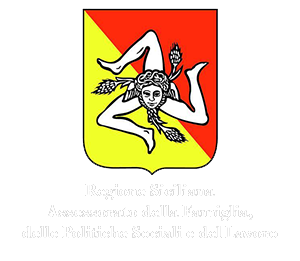History
Photo credits
Diego Barucco | Digital Artist
Walking down the ancient mule tracks which twist and turn sinuously and slowly along the slopes of mount Aita, a melting pot of ages is all around, embracing all at once more than three millennia of history. In these places, a pleasant nature and the white stone, carved by the man's work, tell a story which fascinates visitors still today.
Here lied the ancient settlement of Sortino, a pearl mounted between the powerful rocks of Pantalica and the mount Aita, a blooming center surrounded by rivers, streams and woods, which flourished until 1693, when it was completely destroyed by the earthquake which affected the whole Val di Noto.
After the earthquake, the new town was built on the plain above, where it lies still today, but the site was never completely abandoned and many are the ruins of the medieval city which can still be admired.
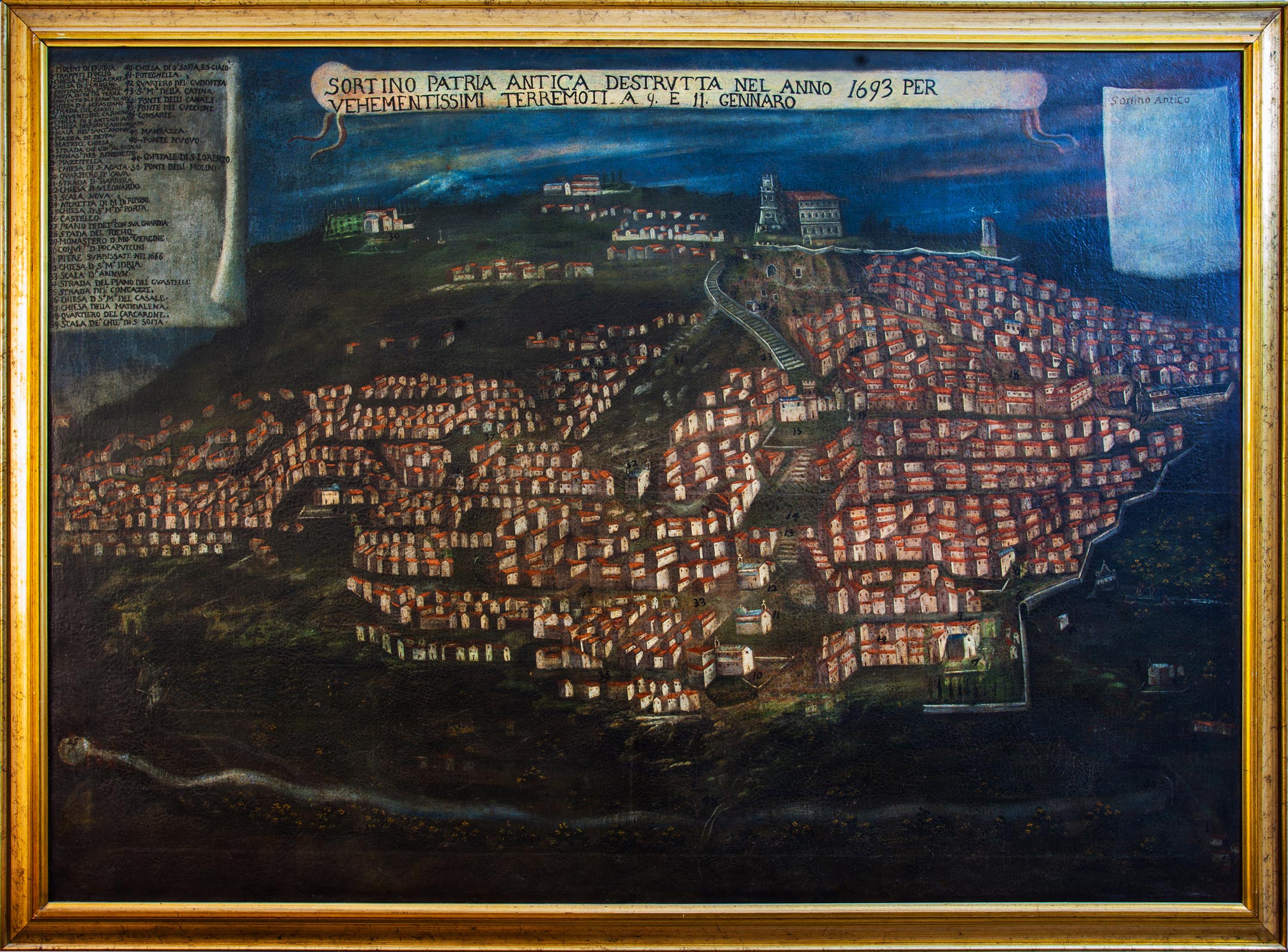
Sortino Patria Antica, olio su tela - ‘700. Autore ignoto. Chiesa di S.Sofia di Sortino. Foto di Diego Barucco.
Prehistory
Among the ruins of the medieval settlement, endure some artificial grotto graves, dating back to the Ancient Bronze Age (Facies of Castelluccio, XII - XVI century BC) and evidence of a consistent pattern of settlements in the area before the rise of Pantalica (XIII century BC).
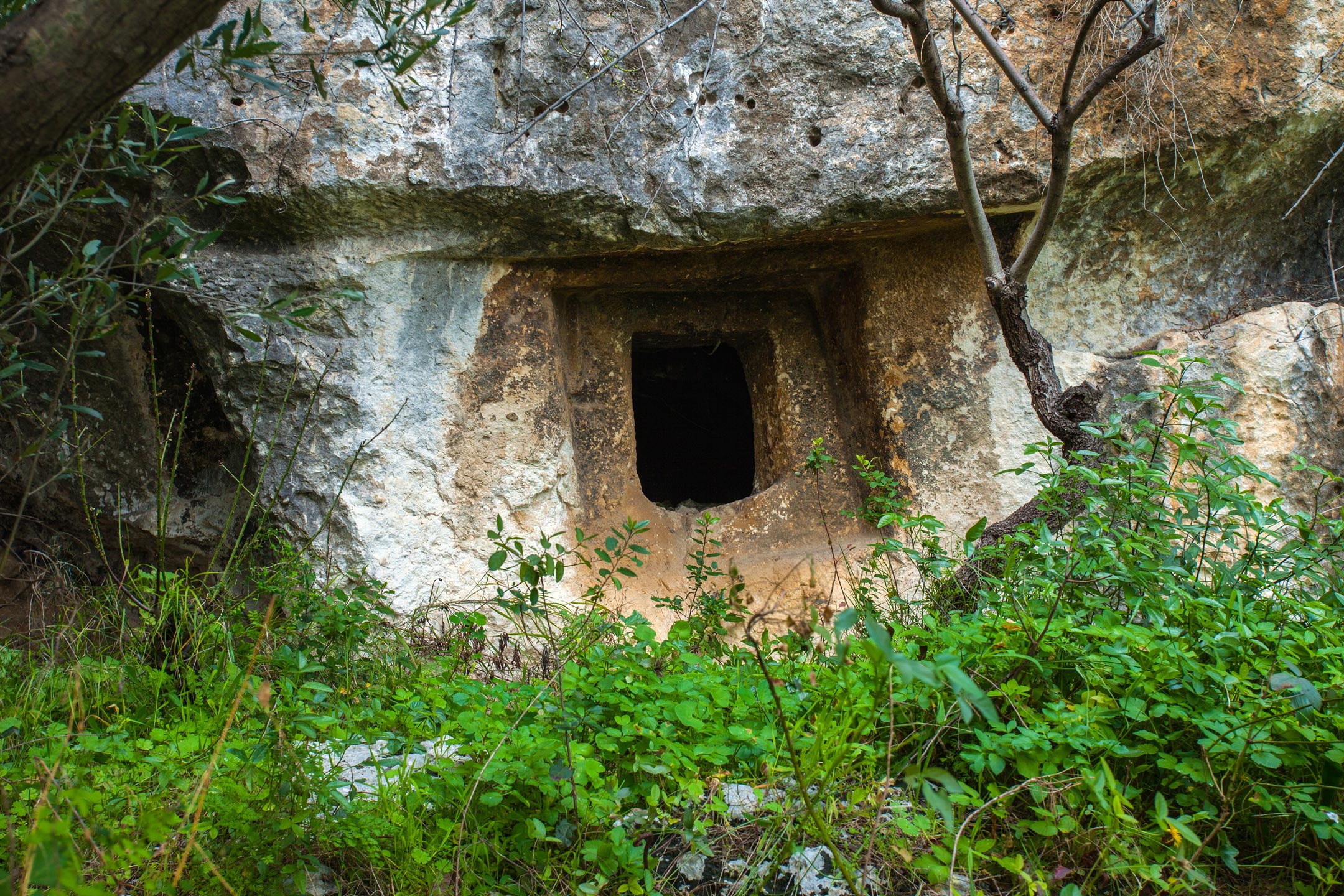
Tomba a grotticella artificiale, facies di Castelluccio, XXII-XVI sec. a. C. Zona Scala Lonca. Foto di Diego Barucco.
Late antiquity
Within the site of the ancient Sortino is a group of grottos (Grotte a' fezza) which was seriously damaged by the 1693 earthquake, but also the remains of some Byzantine hypogeum graves, as indicated by the ruins of an arcosolium (V-VI century AD).
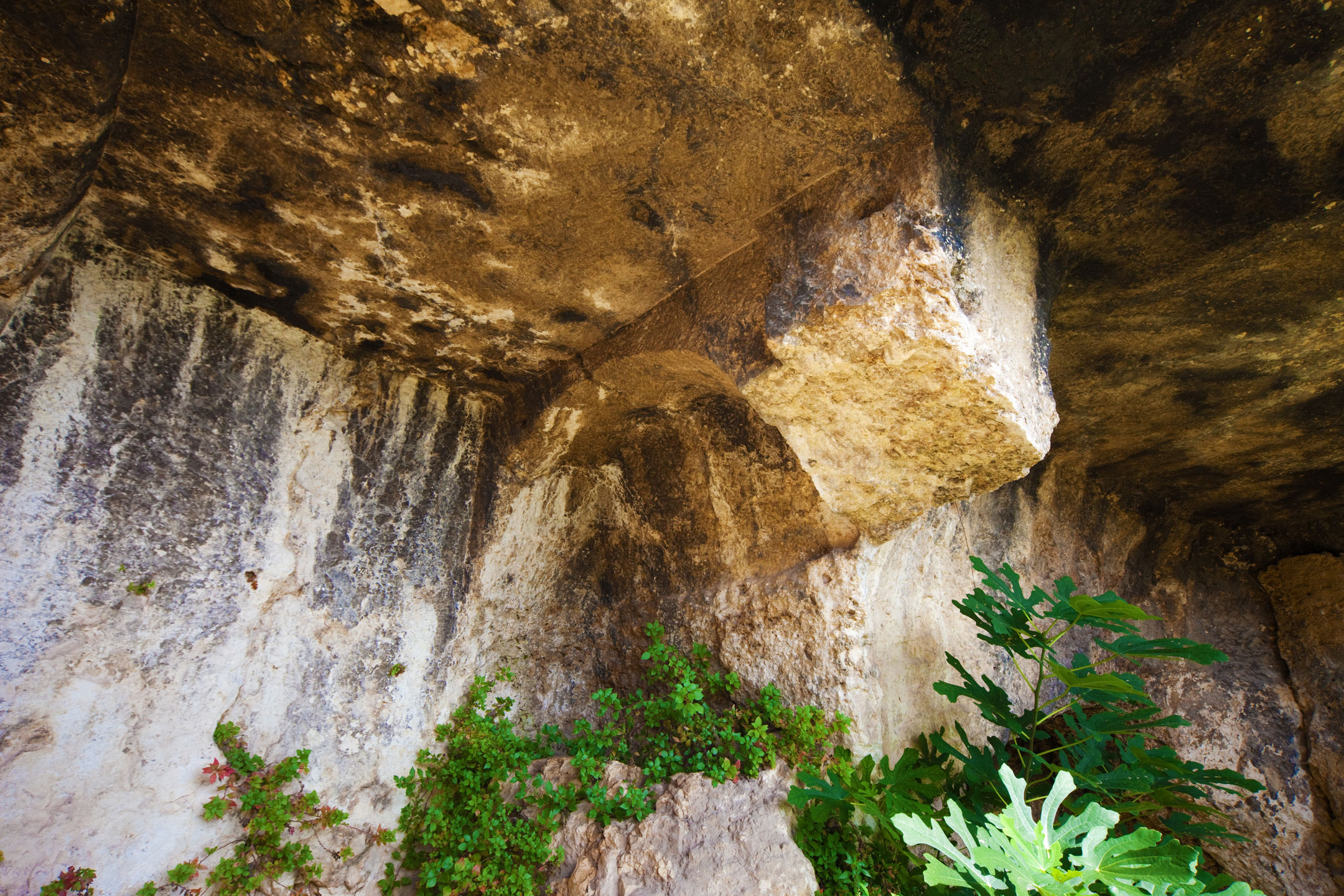
Resti di arcosolio, V-VI sec. d.C. Rutti ‘a Fezza. Foto di Diego Barucco.
Historical origins
1277. reportedly, the most ancient records of the feud of Sortino date back to 1277, when the toponym was used as casale in the Angevin registries. However, there is also a tradition, though not sufficiently documented, which dates back to the Mugnos and lists Sortino among the lands donated by queen Costance to Arnoldo Di Modica between May and November, 1198. Vito Amico maintains that during the second half of the XIV century the feud of Sortino was object of dispute between the cousins Di Modica, Federico and Perrello. The latter, with the help of Artale Alagona, managed to arrest Federico: “he locked him up in prison in the fortress of Sortino, where a few days later Perrello's wife, after having choked him with a lace, threw him down from a high ground” (Amico, Dizionario Topografico della Sicilia, 1859).
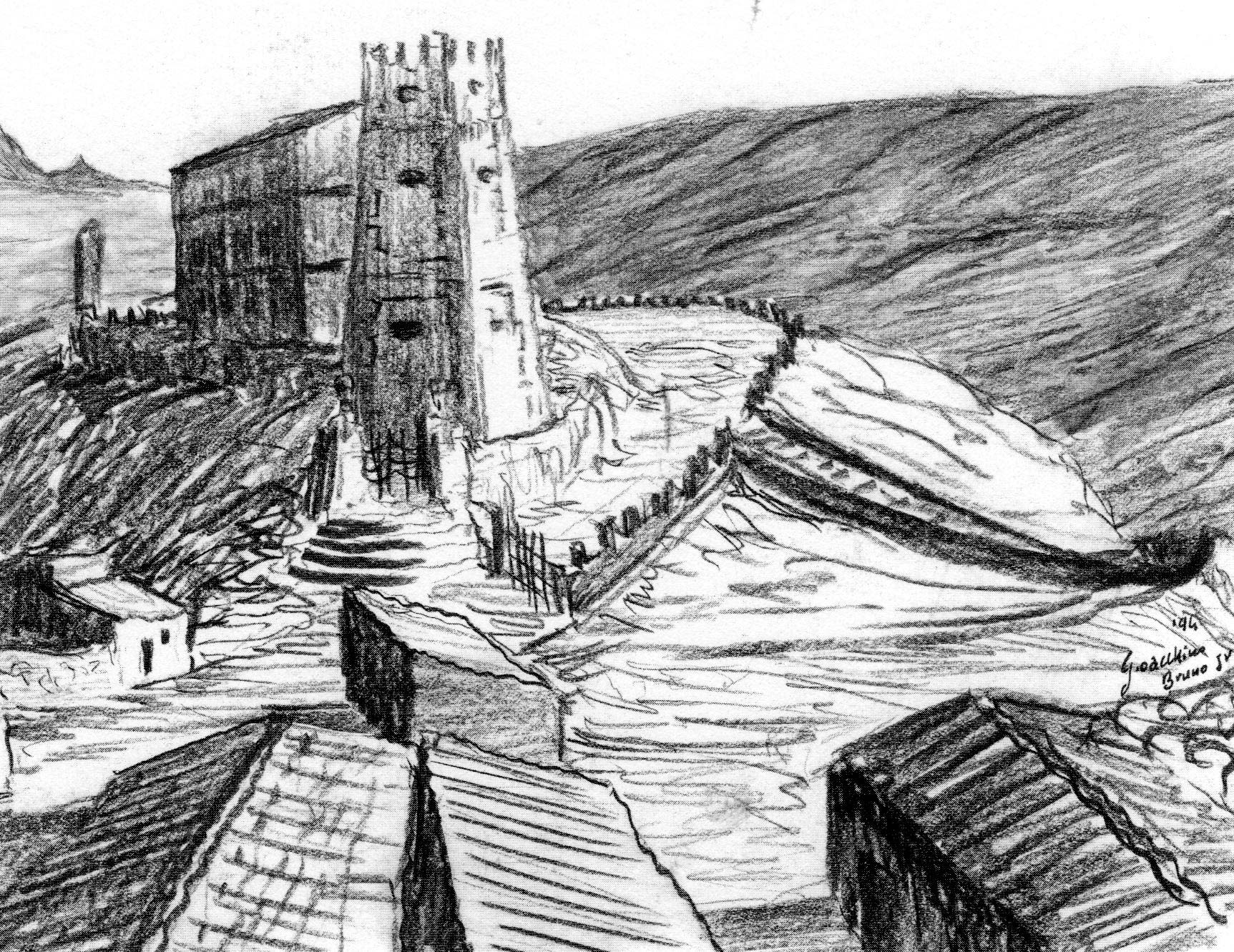
Veduta del Castello di Sortino Antica, carboncino su cartoncino -1994. Gioacchino Bruno. Collezione privata.
1477. The castrum Sortini remained owned by the Di Modica family, then by Ferdinando d'Eredia until, on March 24th 1477, after having received the necessary sale license from the King, he sold it to Guidone Gaetani, progenitor of the family, who kept the possession without obligations and with several accessory rights (waters, mills, hunting, fishing, farmed and non-farmed lands, etc.). The Gaetani family, originally from Pisa, became very soon one of the most important and celebrated of the whole Kingdom. Guidone's father, Pietro, had been fighting in the army of Alfonso V of Aragon and had been President of the Kingdom, while Guidone himself became Portulan of the Kingdom.
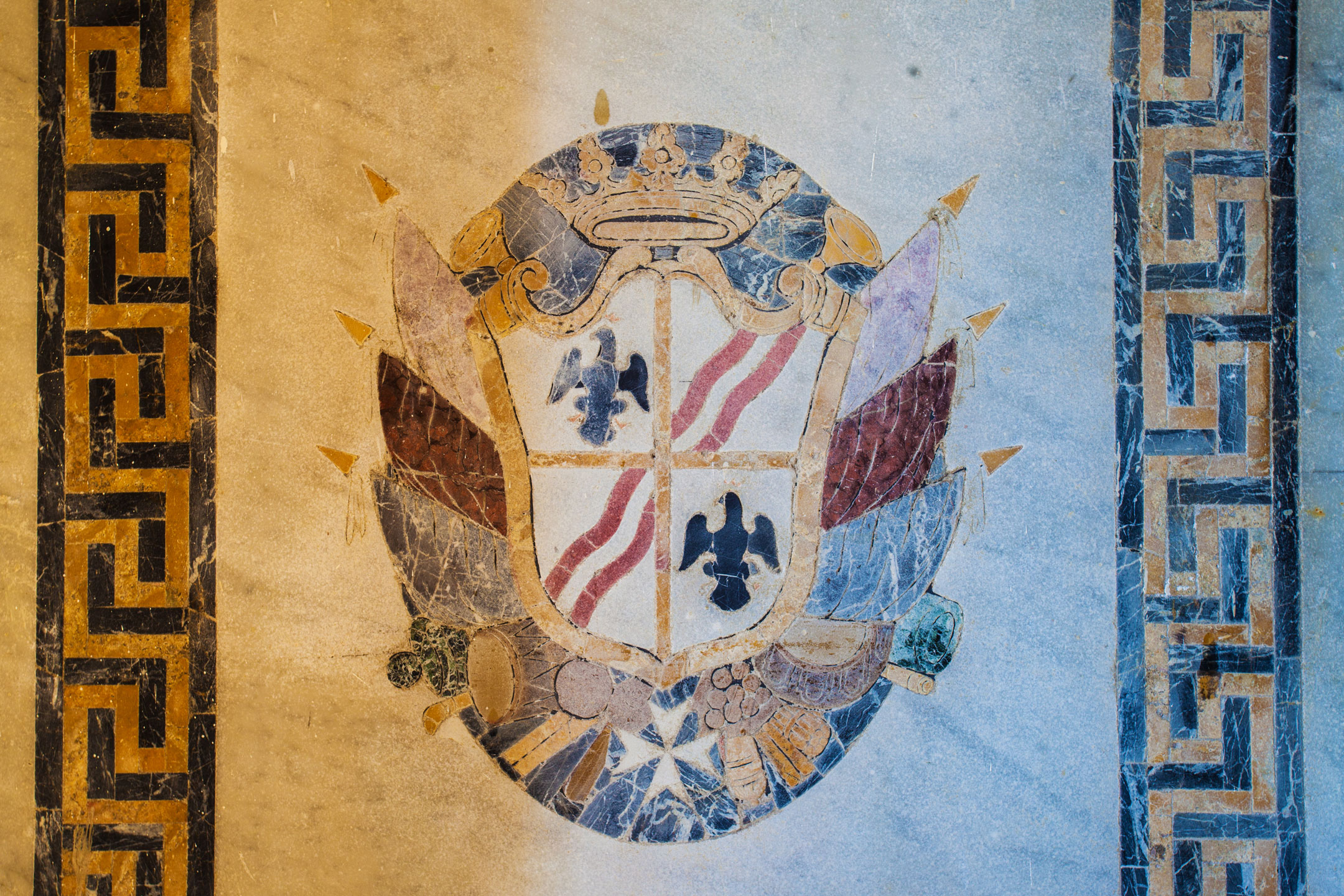
Stemma della Famiglia Gaetani. Marmo - ‘700. Convento dei PP. Cappuccini di Sortino.
Inside the castle was a private chapel:
“in said chapel, built by the Gaetani family, were celebrated four masses per day, while five more masses per week were celebrated by other chaplains.”
Gurciullo, Notizie delle chiese di Sortino, seconda metà del sec. XVIII)
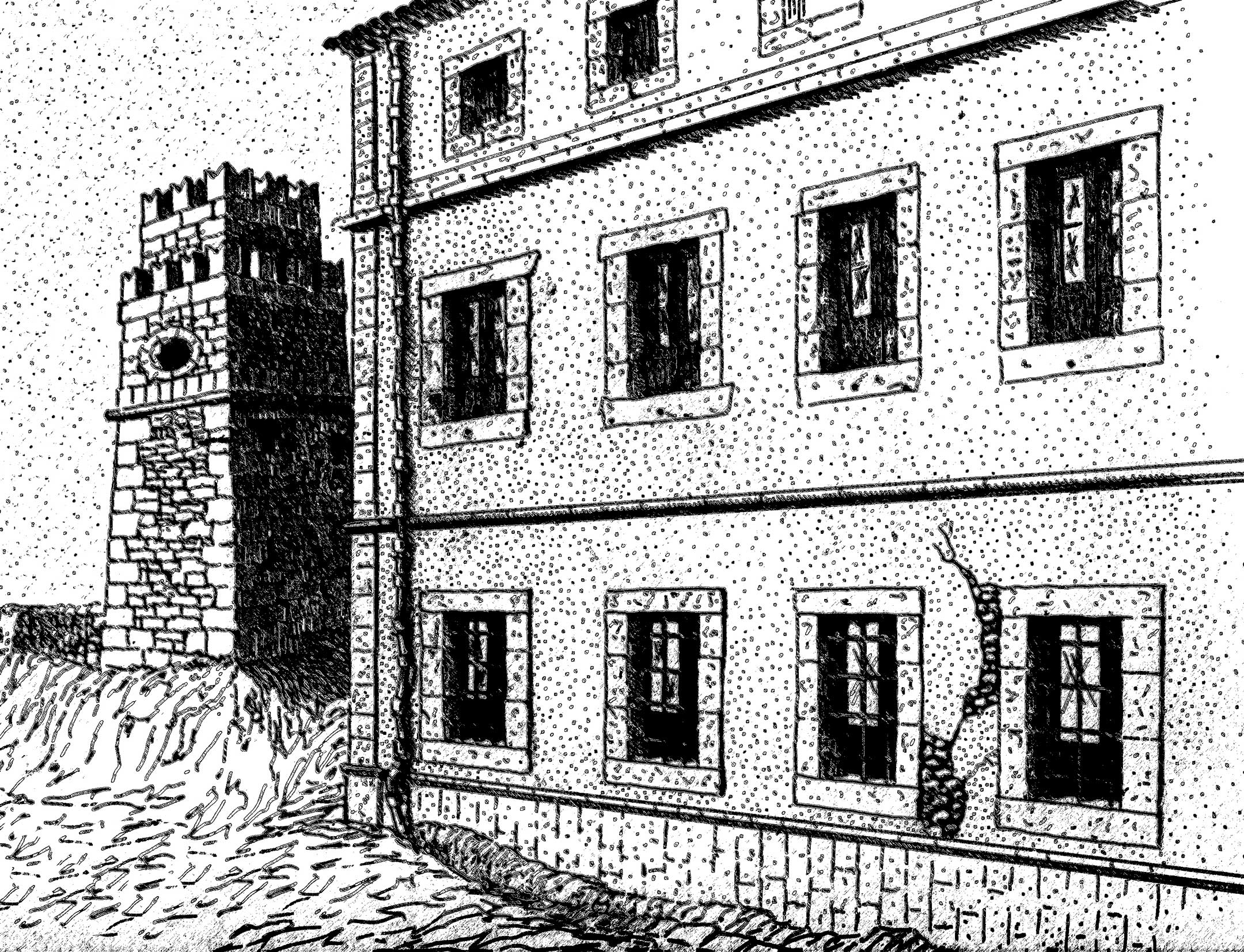
Castello di Sortino Diruta, china su cartoncino - ’90. Gioacchino Bruno. Collezione privata.
1542. Earthquake
“Around this time, in the year 1542, at 11 pm of December 10th, a strong earthquake hit the whole Sicily (...) and by destroying the fortress of Castel Sortino in one instant, it also killed Beatrice, owner of the castle, and her older son Guido, together with many other people.”
Fazello, De Rebus Siculis, 1558
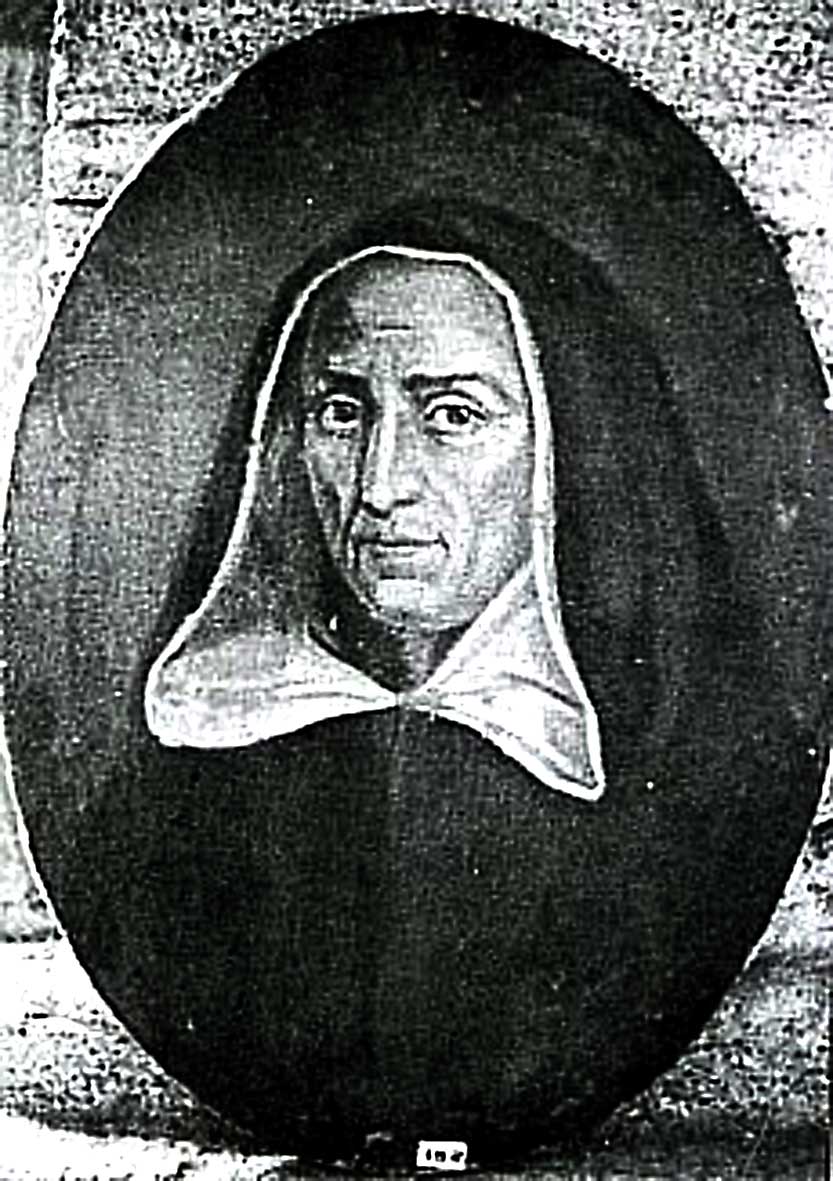
Tommaso Fazello - Storico (1498-1570). Ritratto.
Galermi aqueduct (1576)
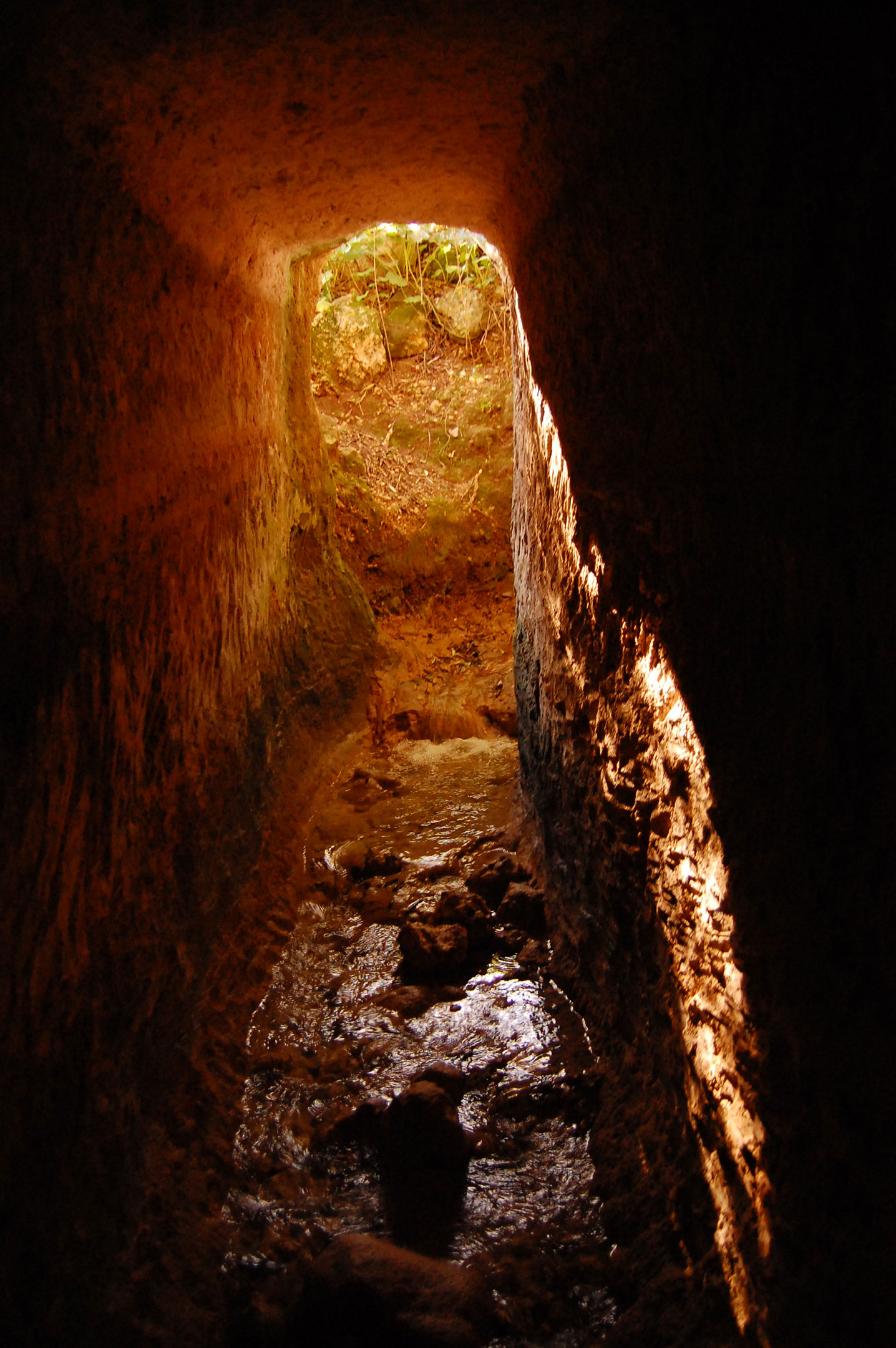
Canale Galermi, Pantalica. Foto di Dario Minnalà.
In 1576, Syracuse was affected by a heavy famine, accompanied by a violent epidemic which pushed the whole city to the limits of survival. Due to the impossibility of providing for the water needs of the population, the city senate struck a deal with the baron Pietro Gaetani, according to which the waters coming from the springs of Sortino and Cassaro would be made flow into the aqueducts and reach Syracuse through them. The deal turned out to be very good for the baron, who reactivated at his own expenses the ancient aqueducts of Galermo, “an admirable work, [the aqueducts were] astonishing for their width, height and length, reason of wonder and amazement in those who saw them”, getting in exchange the right of possession of the waters and the mills, for himself and his heirs. This immense work costed one-hundred thousand onzas. “The age and the builder of such aqueducts are unknown. Some believe the builder was Dionisio the Great. (...) it would be more fair, for such a gigantic work, to assert that the builder was actually Gelone, whose reign started on the 73rd Olympiad. Said ruler, having earned a considerable number of prisoners following his victory on the Carthaginians, is told to have put them to work on the construction of the aqueducts. Alternatively, it could have been the subsequent ruler Gerone to build them, right after the death of Gelone, on the 75th Olympiad, 477 BC” (Gurciullo, Saggio storico critico su Erbesso, 1793).
Territory. Announcements.
During their dominion, which lasted for fifteen generations, the Gaetanis also carried out a form of protection and safeguard of the territory and the environment of Sortino, as proved by the number of announcements regulating the life of the community. For instance, it was prohibited to “piss into the fiumare of such land from November 30th to the first day of Lent, in sign of respect for trouts, which around this time lay eggs. And, furthermore, in sign of respect for the drinkable waters, “it is ordered and commanded that no person installs channels to use the water from this fiumara” (Banni et ordinationi, XVII - XVIII centuries).
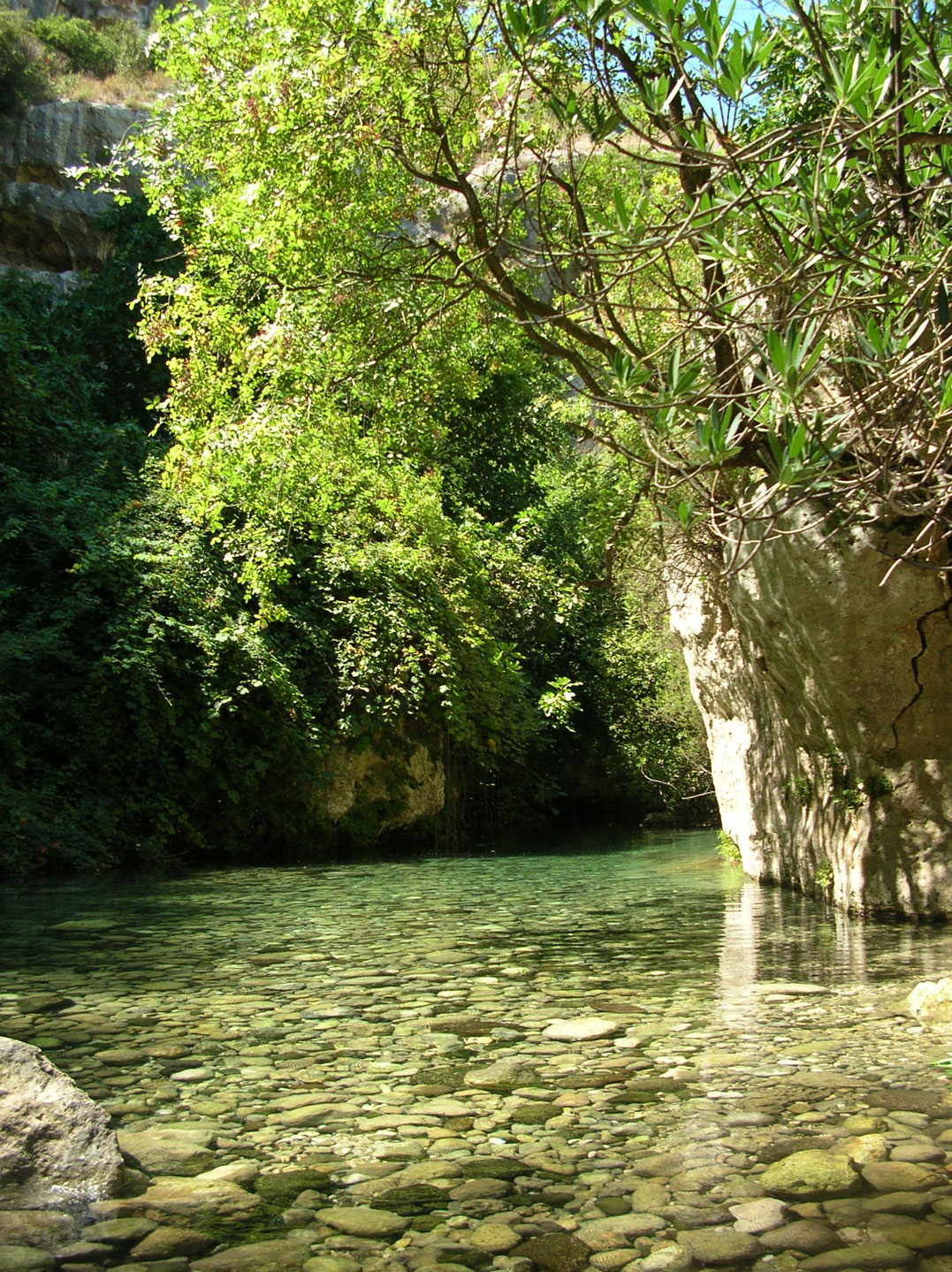
Fiume Bottiglieria – Pantalica. Foto di Dario Minnalà.
1557. The Miracle of the Annunziata
In 1557 a miracle took place in Sortino. An old painted illustration of the Annunciation was kept in the church of the SS. Annunziata. Due to the heavy rains, “a big stream tore down the church and took the painting away, which however floated on the water in a vertical position, with the face always pointing towards its beloved Sortino, until it got to the junction with the sea of Syracuse (...) In this position, standing and with the face towards Sortino, the painting was seen by a citizen of Syracuse, by the name of Nicolò Trajna. He informed his wife, who was originally from Sortino, and the painting was immediately recognized as the one from the SS. Annunziata in Sortino. The good news of the recovery was then given to the people of Sortino, busy with the search parties for the holy image” (Gurciullo, Notizie delle Chiese di Sortino, second half of the XVIII century).
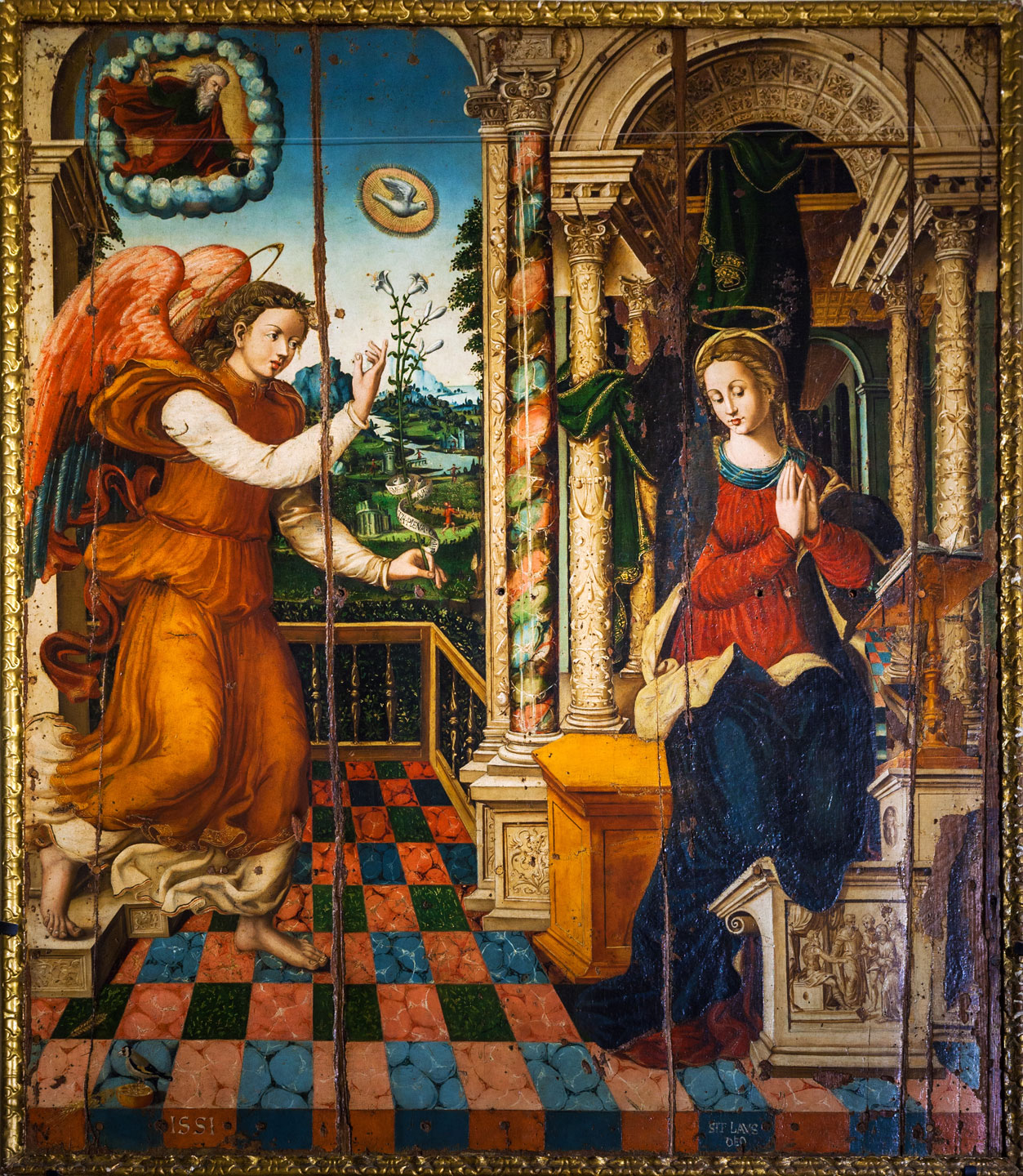
Annunciazione, olio su tavola – 1551. Autore Ignoto. Chiesa Madre di Sortino( Diritti Riservati ). Foto di Diego Barucco.
1647. The fire of the archives
In 1647, due to the introduction of new taxes on the flour, the people of Sortino rose up and “all the writings were burnt in that year, with a considerable loss for this Universitas, and only few documents remained, later found randomly in the houses of the notable people and in the houses of some notaries” (Gurciullo, Notizie delle Chiese di Sortino, second half of the XVIII century).
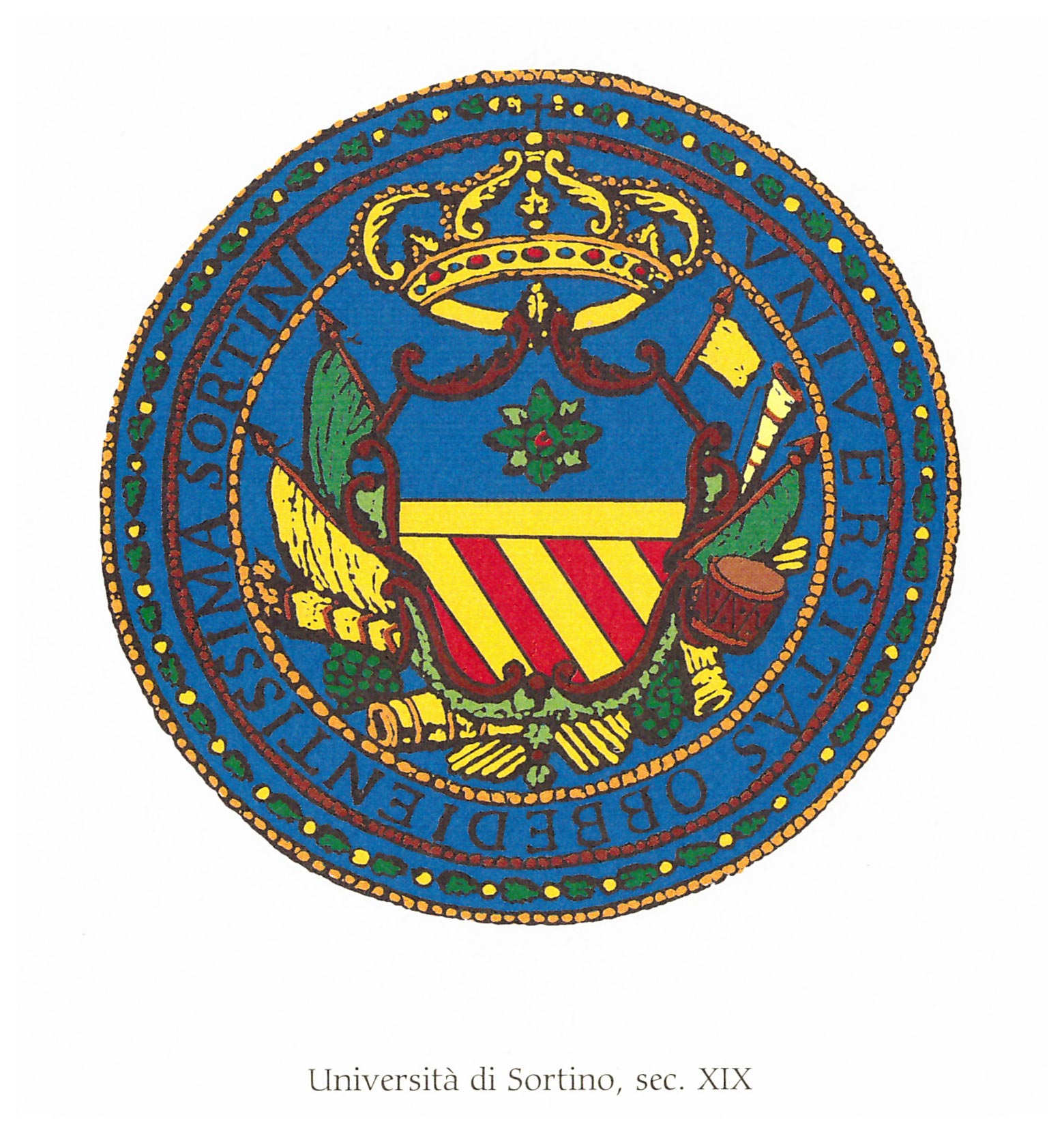
Stemma dell’Università di Sortino.
Ancient chiesa madre and scala nova
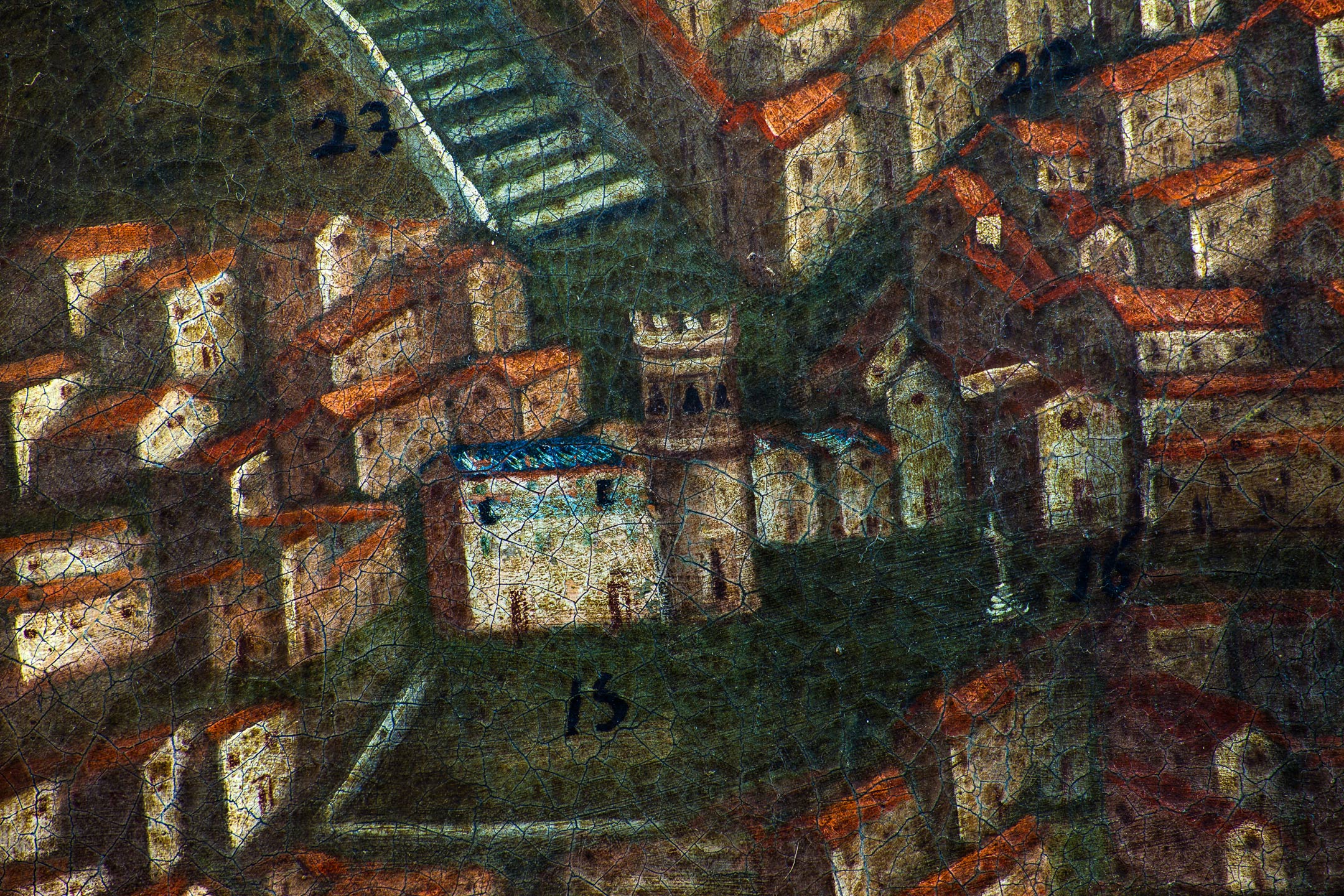
Sortino Patria Antica – Particolare. Chiesa Madre e Scala Nova. Foto di Diego Barucco.
The chiesa madre (mother-church) of the ancient Sortino was located in the center of the urban complex, not far from the scala nova (new stairway). According to the old men of the town, the ones who survived the earthquake, it was quite tiring to go all the way up the stairs without a break, therefore, exactly at the half of it, a recess was carved into the rock, and it was dedicated to S. Maria del Riposo (Bruno - Ingaliso, Sortino tra leggenda e realtà, 1993).“We describe the location and the position of the mother church as it was before the earthquake of 1693, in the center of the city, close to the new stairway, according to what is told by the old men still living. It was tall, large and spacious (...). Its length extended from East to West, although the location of the doors was badly arranged, as the place where it had been built was in poor condition.” (Gurciullo, Notizie delle Chiese di Sortino, second half of the XVIII century).
Nothing was left of the ancient mother-church after the earthquake of 1693, but many ruins and materials were retrieved from the ancient site and used to build the new mother-church in the XVIII century. In a collection of payment mandates for the construction of the new mother-church, it is still possible to find noted an expense of 18 tari to twelve men who took the baptismal font from the destroyed mother-church to the new one, 17 tari and 10 grana paid to Antonio Guarino and others for having dug carvings in the ruins of the old mother-church and transported them to the new one. One more expense of 1 onza and 8 taris to master Giuseppe Mazzotta, master Giorgio Rio and others for having worked nine days and a half to retrieve the big bell to be rung on the day of the commemoration of the dead and for having fixed the wooden frames on the bell pillars.
S. Agata
The sources tell us that, in ancient times, the mother-church of Sortino was the small church dedicated to St. Agatha, which was located “beyond the castle from the Eastern part (...) The judgment about what is told by the old men is left to the reader, but it is necessary to reflect on the fact that the mother-church, although relocated, should have still been dedicated to St. Agatha, rather than to St. John Evangelist as it is now indicated on the facade (...) Since it is maintained that the town was originally small and grew in size only after the Gaetanis became its lords in 1477, the construction of new houses started around that time and, in order to provide the citizens with closeby spiritual support, the mother-church was moved to the center of the town and that small church remained dedicated to St. Agatha (...) This church is very ancient, although it was destroyed by the earthquake of 1547 and re-built afterwards.” (Gurciullo, Notizie delle Chiese di Sortino, second half of the XVIII century).
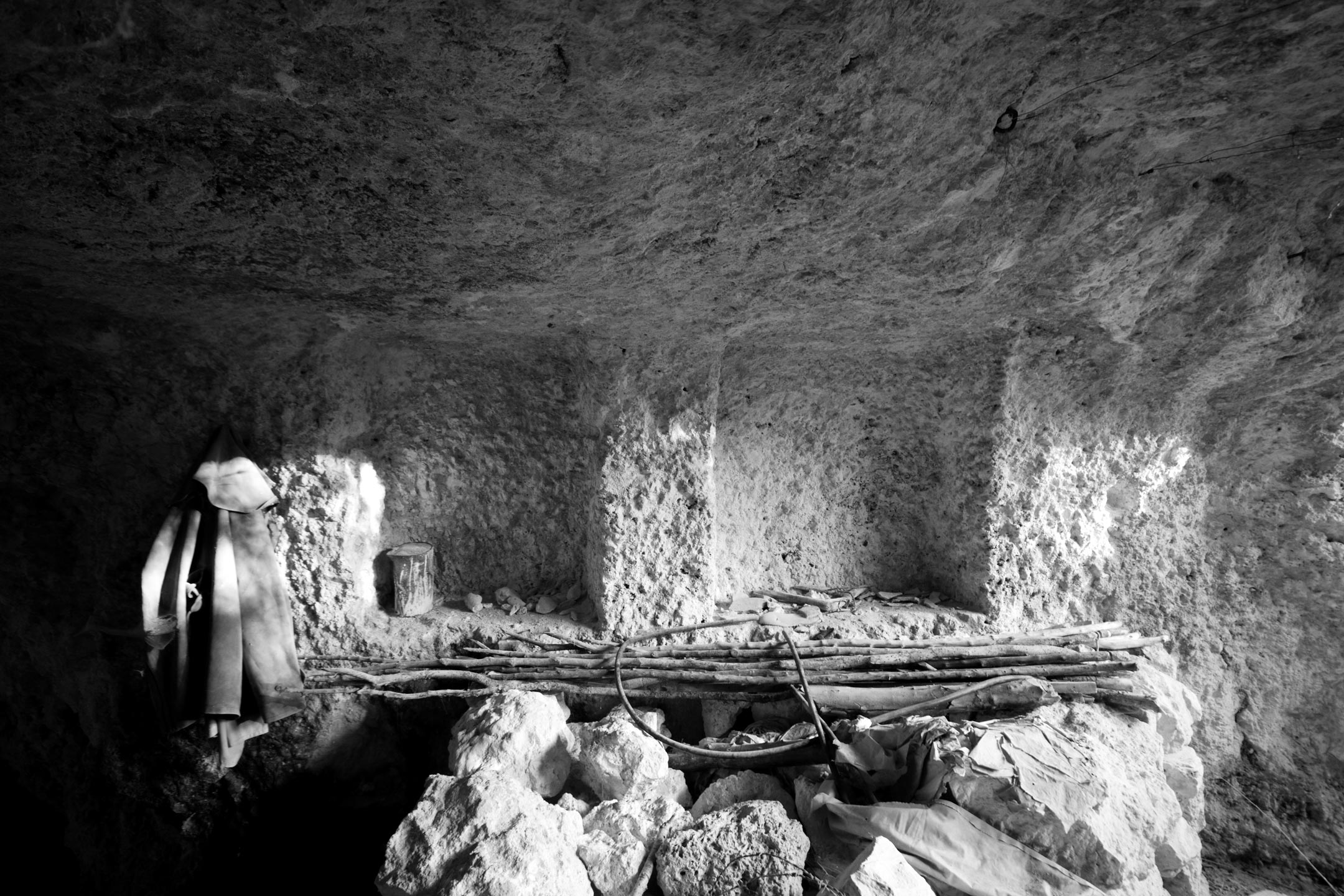
Ruderi della Chiesa di S. Agata. Foto di Diego Barucco.
S. Leonardo
A church of uncertain origins is that of St. Leonard. From a pastoral visit of 1543, we learn about an aid fund instituted for this church already back in 1471. “It was already a well-adorned church and I do believe so due to the fact that it had its own confraternita. The main altar was dedicated to St. Leonard, but there was a second altar dedicated to Jesus Christ Resurrected, which was taken around the streets of the town in procession on the day of the Resurrection.” (Gurciullo, Notizie delle Chiese di Sortino, second half of the XVIII century).
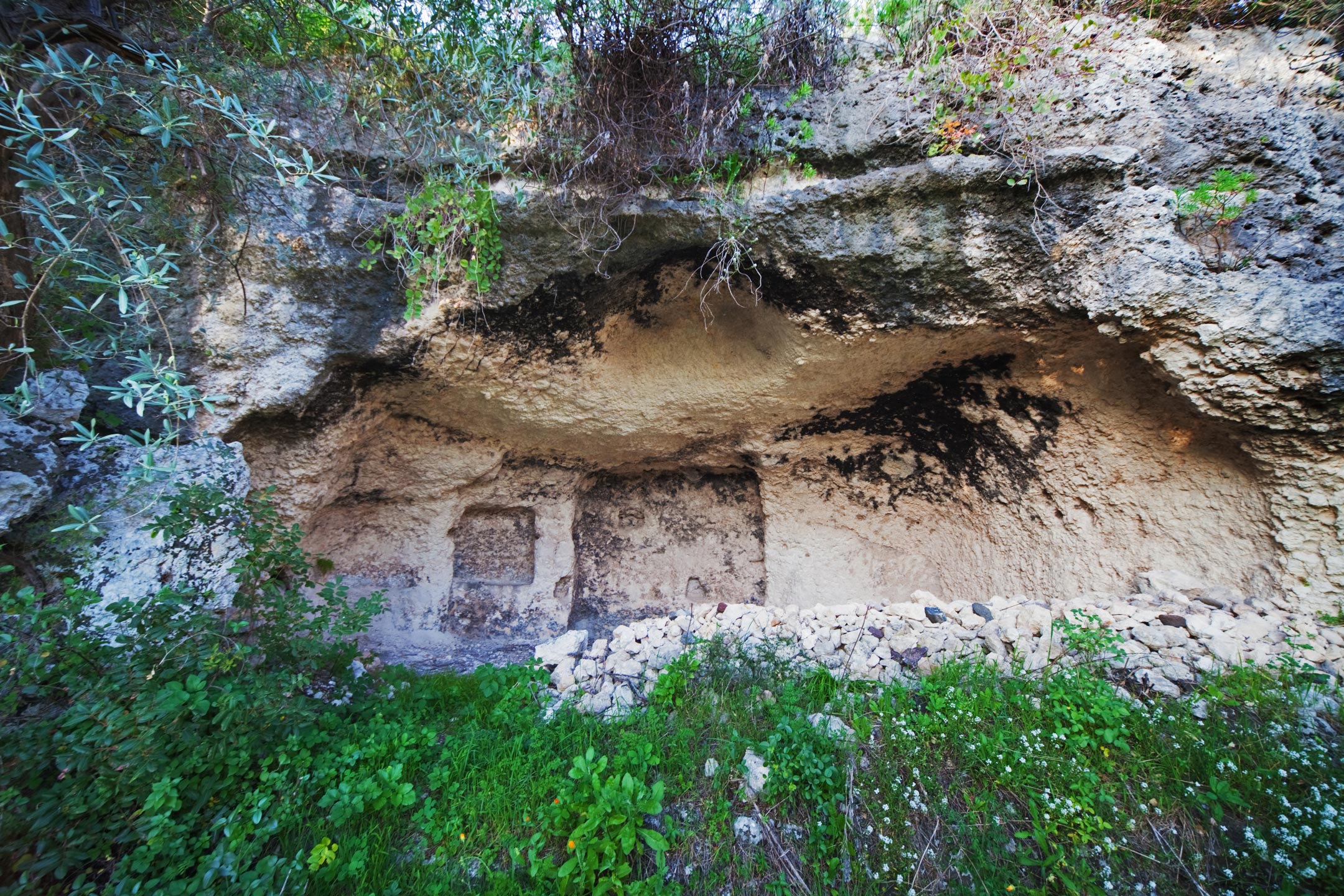
Ruderi della Chiesa di S. Leonardo - Altare. Foto di Diego Barucco.
The Holy Way
During the Lent, the devoted walked the so-called Holy Way. This “started where the concazze were. Here was the first small recess, which was followed by four more along the way (one of which, featuring an image of the Ecce Homo, is still visible today), and ended at the Calvario Mount, in front of the church of S. Pietro. Afterwards, the people walked up the utra utra which led to the small fountain and by this way reached the church of S. Maria del Carmine, located at the top of the main street, where was the Congregation of the Five Plagues” (Gurciullo, Notizie delle Chiese di Sortino, second half of the XVIII century).
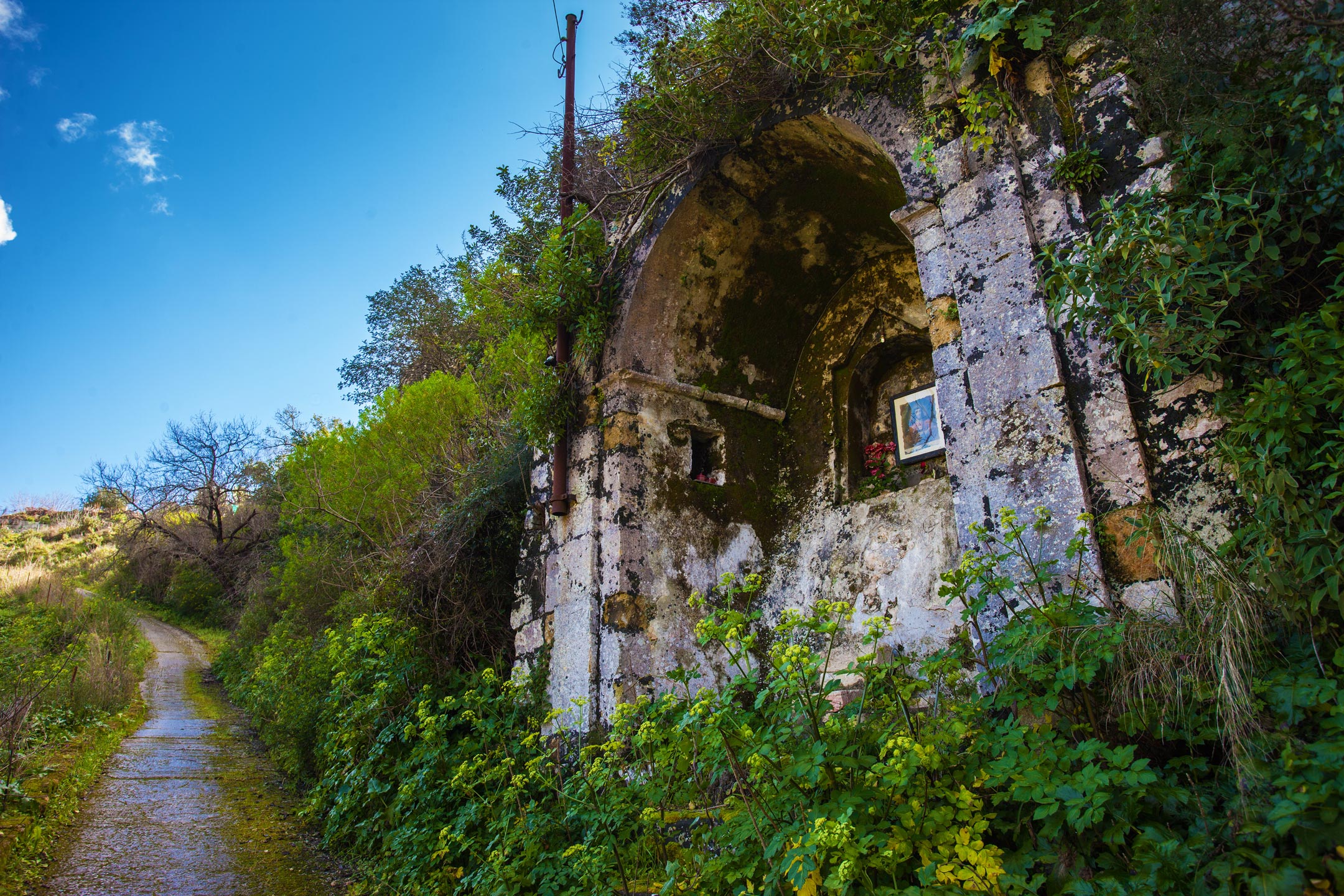
Nicchia dell’Ecce Homo. Sentiero Utra Utra. Foto di Diego Barucco.
The Congregations
The Congregation of the Five Plagues was the most ancient one, instituted in 1637 and based in the church of S. Maria del Carmine. Its members “needed to have their vest blessed and then to wear it as a sign of the sons and brothers of Virgin Mary (...) and to confess and take communion all Fridays of March and every four Sundays, with the exhibition of the Holy”. In case of sickness or death of a member “all members had to come together and make the exercises of agony and celebrate three masses (...) alternatively three members, including a priest, assisted the sick for two hours and then in case of death all members accompany the body with only the vest and the black hat, bringing in front of them only the naked cross”. Furthermore, they had to “help the poor brothers with charity, celebrate masses for them and take care of the funeral services. All brothers contribute seven granas as charity for the funeral services and for the anniversary of the earthquake”. Also, it was not possible to accept a member who had been kicked out by another congregation or expelled twice by his congregation before (Gurciullo, Notizie delle Chiese di Sortino, second half of the XVIII century).
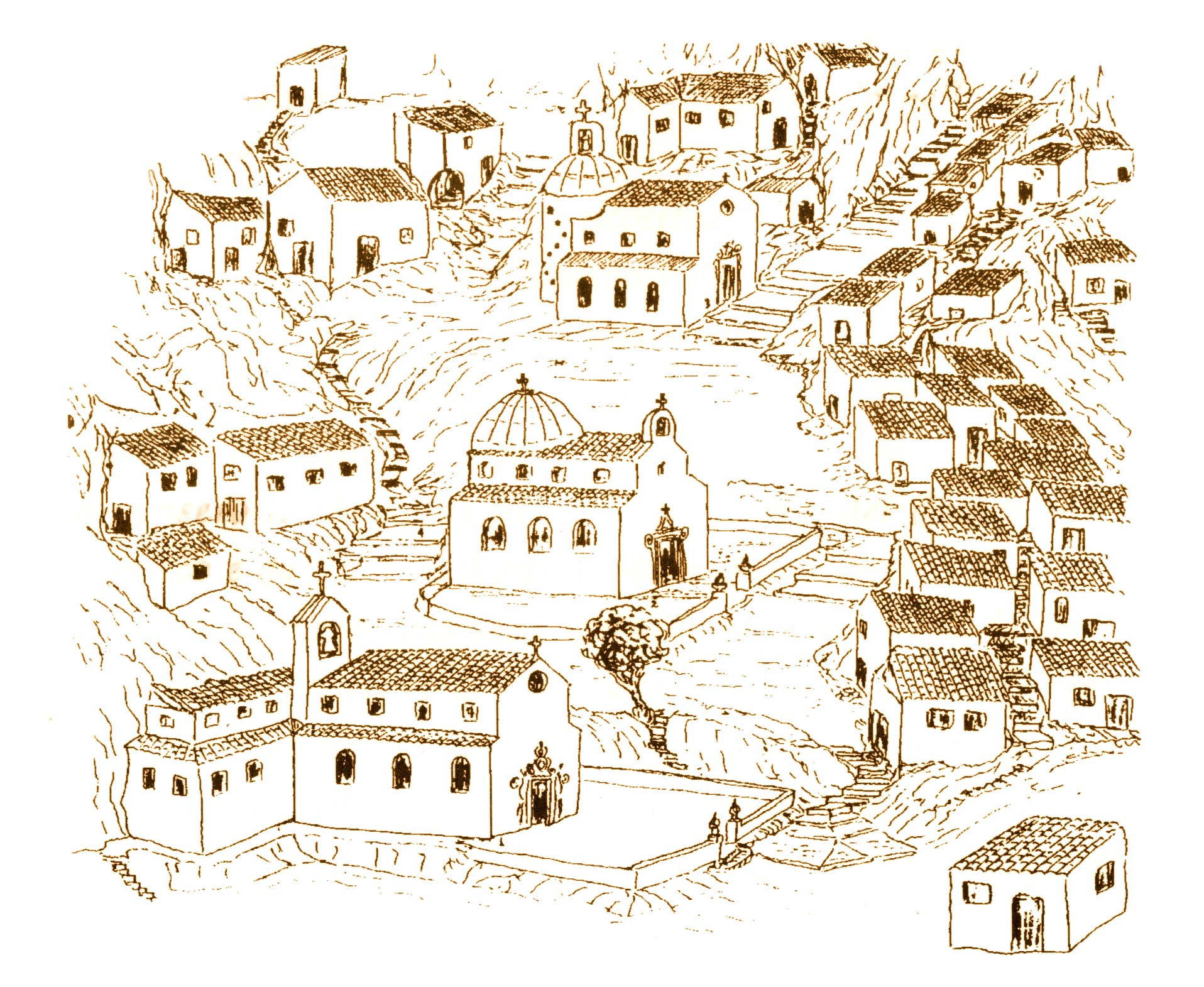
Chiesa dell’Annunziata, di S.Antonio Abate e Convento del Carmine della Sortino Diruta, china su cartocino – 1993. Gioacchino Bruno. Collezione privata.
The confraternities
There was also a high number of confraternities, “which in ancient times rose for the high number of members and for the devotion and fervor. There were six confraternities, each based in one specific church: SS. Annunziata, S. Vito (...), S. Sofia, S. Antonio Abbate, S. Leonardo and S. Sebastiano. We have no memory of the age of any of these confraternities. Their duties were mainly to elect the procuratore, the tesauriero and the cappellano of the church every Monday evening after the Easter” (Gurciullo, Notizie delle Chiese di Sortino, second half of the XVIII century).
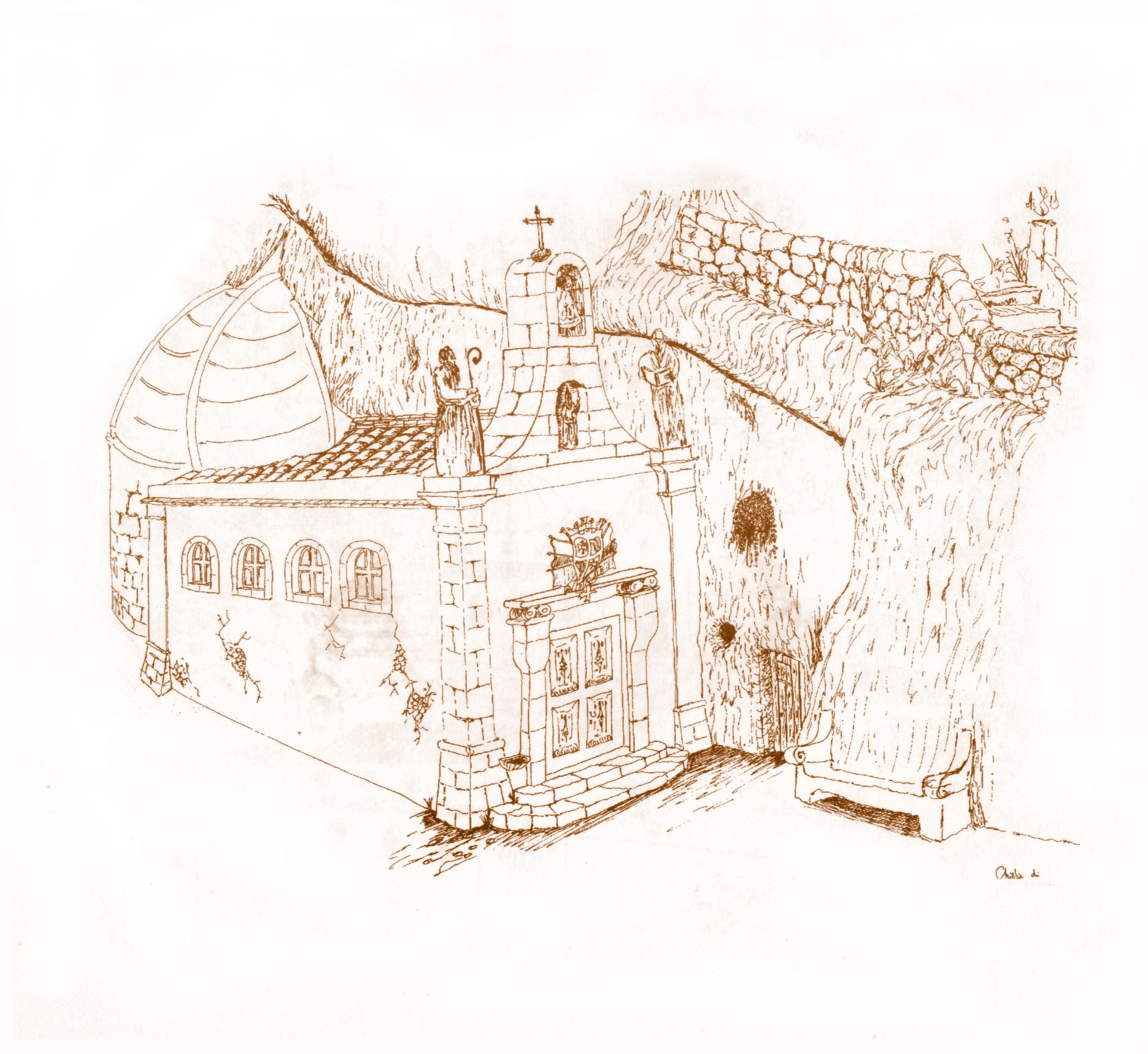
Chiesa di S. Antonio Abate della Sortino Diruta, china su cartoncino – 1993. Gioacchino Bruno. Collezione privata.
The companies
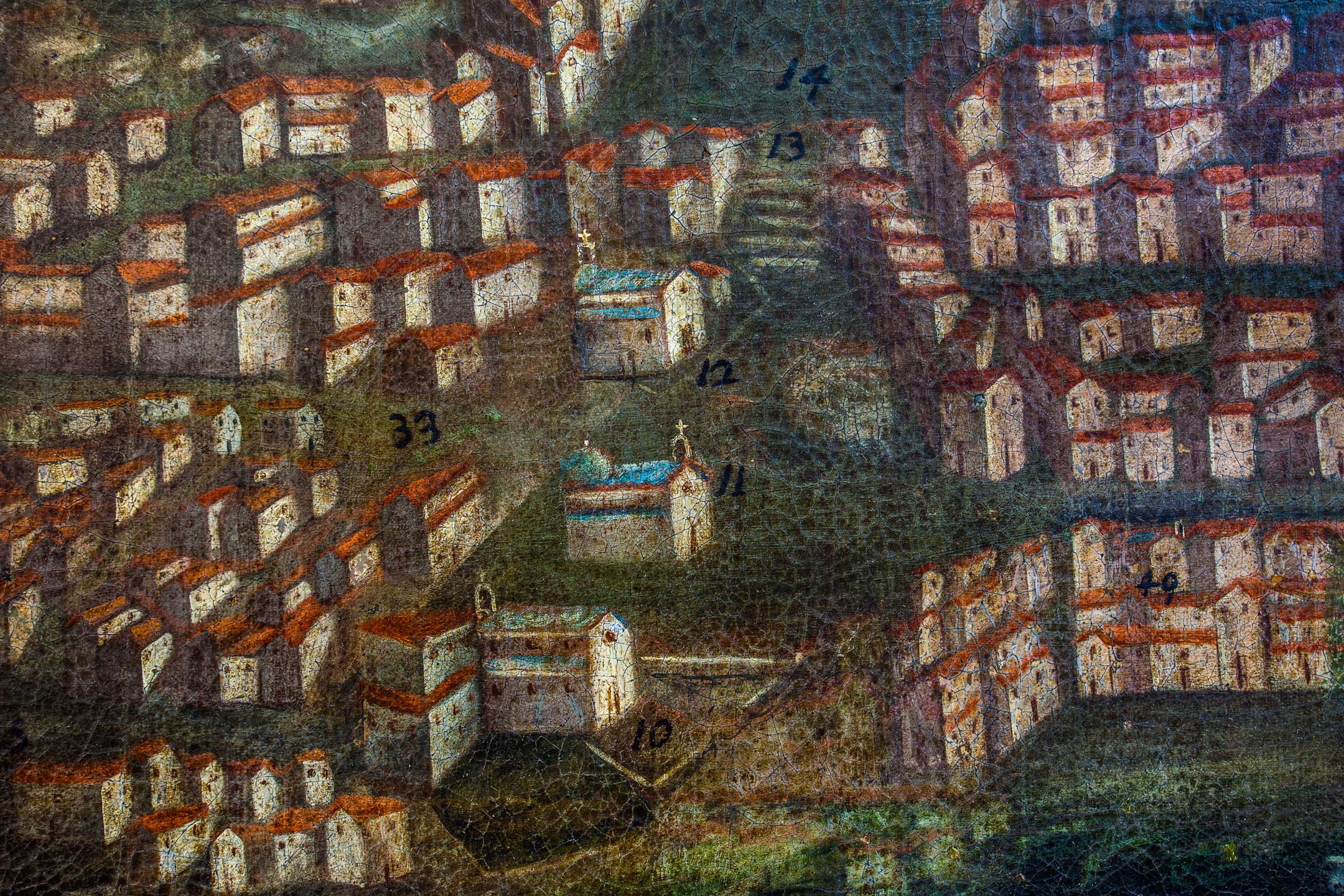
Sortino Patria Antica – Particolare. Chiesa dell’Annunziata, di S.Antonio Abate e Convento del Carmine. Foto di Diego Barucco.
There were also many compagnie, companies. “Called so to discern them from the confraternities (...), they were unions of many devoted brothers and Christians with their own rules, constitutions and local chapters”. There were four of them in Sortino: “the venerable Company of the Immaculate Conception, the Company of the Holy Rosary, the Company of Saint Mary of the Carmel and the Company of the Holy Sacrament”. Among the most ancient companies was that of the Immaculate Conception, founded in 1556. Its members had to comply with a number of obligations. The first one was that of “getting confession every second Sunday of the month and take part, in the evening, to the procession of the Saint”. Another one was that of “giving each brother 5 granas as charity every month, to be used for the celebration of the Immaculate Conception”. When a member died, “the Company has to bury him in its chapel and provide very honorable funeral service, with masses read and sung for the soul of the departed brother (...) and to take the body in procession with all brothers wearing the company vest”. Each member had to have “his vest, hat, ash grey cape and torch (...). The number of members of this company in 1662 was of about four hundred, according to its registry” (Gurciullo, Notizie delle Chiese di Sortino, second half of the XVIII century).
S. Maria d'Itria
The church of S. Maria d'Itria is of uncertain origins. We know it was located “under a cliff not really safe to stay under, due to a crack which was clearly visible and was getting larger and larger with the passing of time (...). The church eventually collapsed on November 6th, 1666, on a Sunday, also damaging many houses and people (Gurciullo, Notizie delle Chiese di Sortino, second half of the XVIII century).
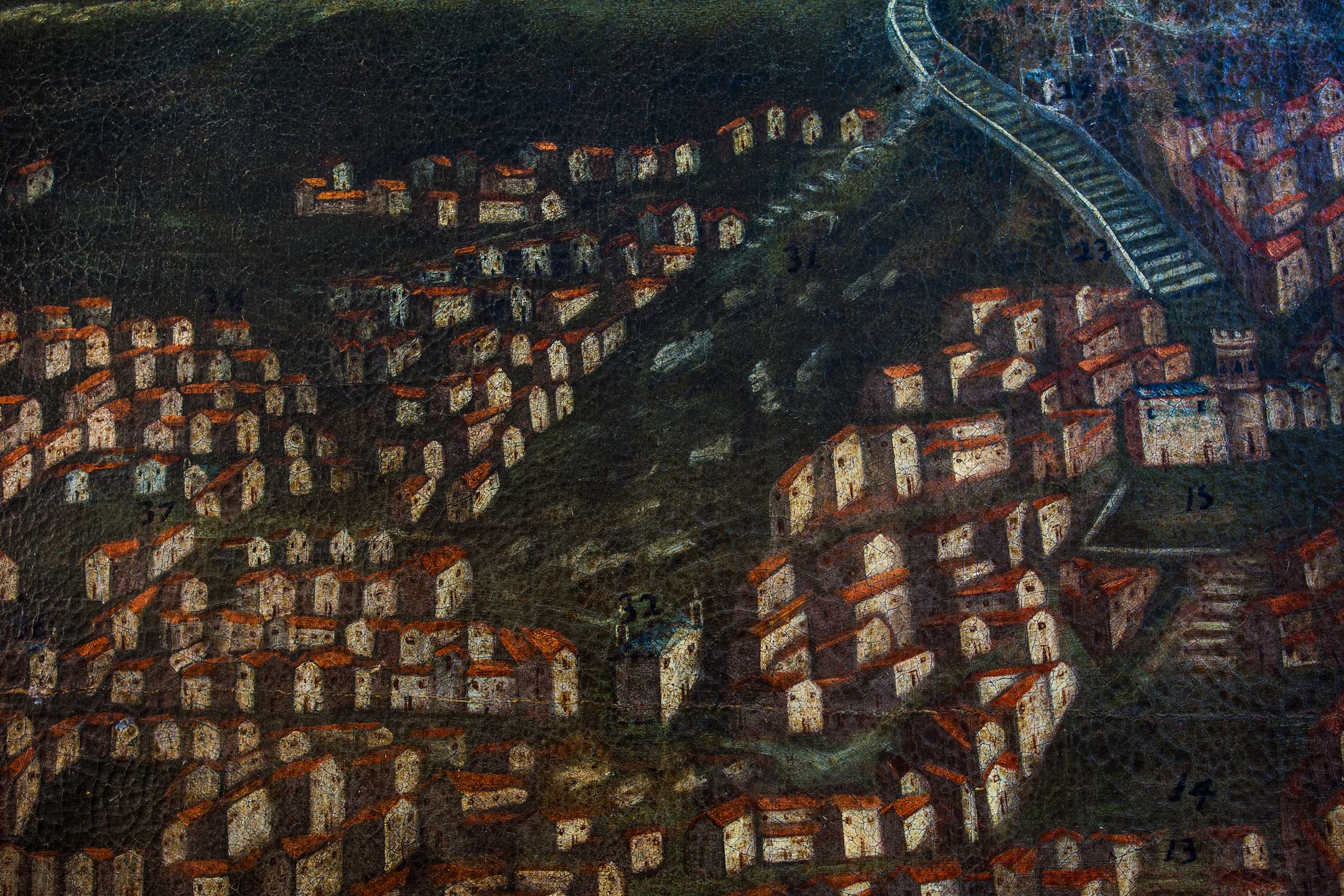
Sortino Patria Antica – Particolare. Chiesa di Santa Maria d’Itria e pietre subissate nel 1666. Foto di Diego Barucco.
Hospital of S. Lorenzo
The hospital was built near the church of S. Lorenzo, to allow the patients to take part to the religious ceremonies and thus satisfy their devotion; “the hospital was separated from the church by a gate, and the patients were accommodated in the lower floor, where was the infirmary. The upper floor was the church, where the Holy Mass was celebrated” (Gurciullo, Notizie delle Chiese di Sortino, second half of the XVIII century).
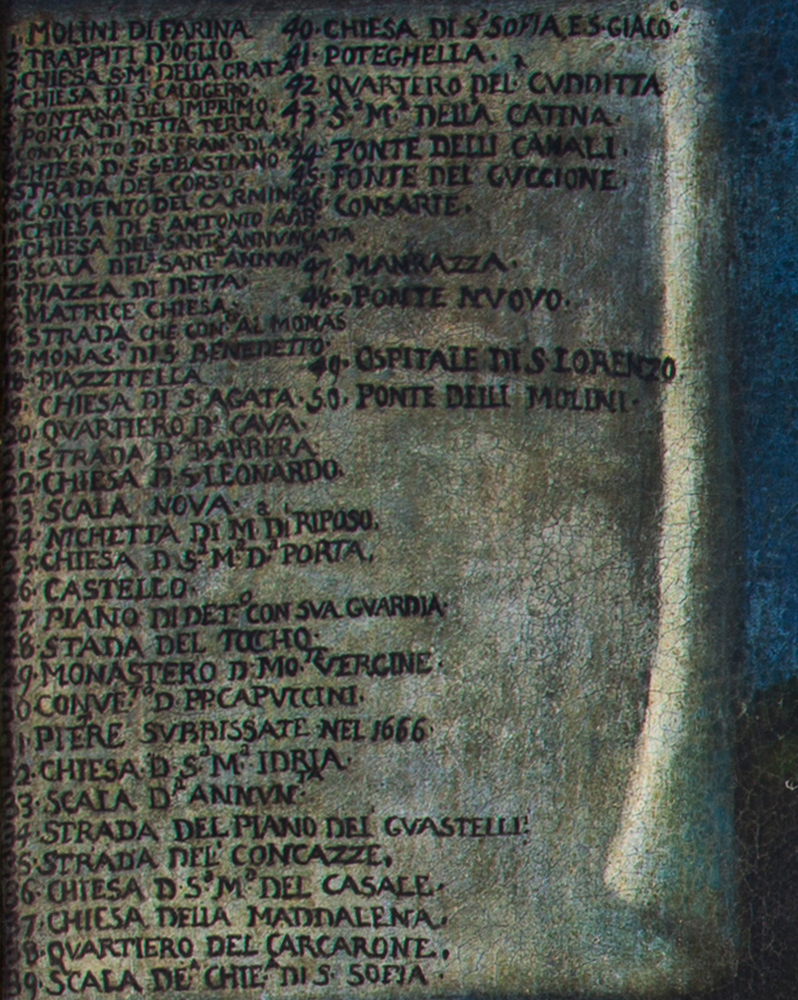
Sortino Patria Antica – Particolare. Legenda. Foto di Diego Barucco.
Santa Suffia arrassu
A church the devoted venerated a lot was that of Santa Suffia Arrassu. It was about five-hundred steps away from the city, on the other side of the spring called “well of S. Sofia”, leaning on a small cliff on the western side. The origin of this church is not a mystery, as it is known it was built after the martyrdom of the Saint, which took place in the year 203 AD”.
“They say that this sanctuary was inhabited by hermits, despite the two small rooms, still visible among the ruins, were not really comfortable. They were connected to the church through a door we can still see closed today” (Gurciullo, Notizie delle Chiese di Sortino, second half of the XVIII century). Until a few decades ago, on each of the seven Wednesdays following Easter, in conformity with an ancient carmelitan tradition, here were practiced excercises of piety and devotion for the Saint. In case of calamity or serious sickness, women used to walk to this church in pilgrimage, with untied hair and bare feet, reciting the rosary of S. Sofia and traditional prayers. Still today the devoted come to this site every year in the days between the celebration of the Saint and the ottava of the Saint patron.
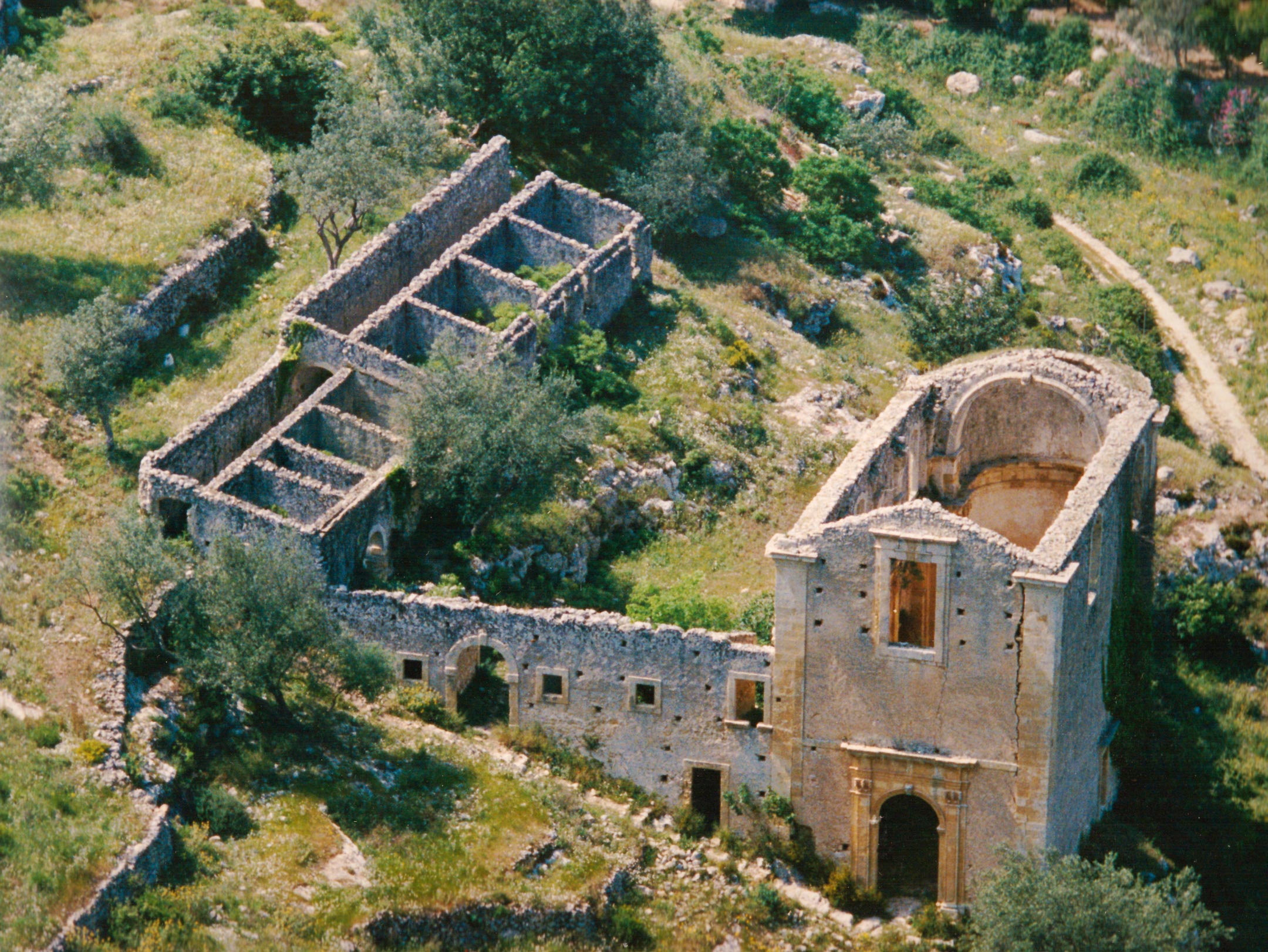
Ruderi dell’eremo di Santa Sofia arrassu, prima del restauro ( 2001 ). Foto di Gioacchino Bruno.
Monastery of S. Benedetto
The Rule of St. Benedict had always had a very strong following in Europe, and also Sortino had a female benedectine community with its monastery. “It is not known exactly when the monastery was built, we can only say it was of excellent workmanship (...). The number of the nuns before the earthquake of 1693 was nineteen, among which many were eminent by both blood and sanctity, such as Maria Stella Rossi, who was seen after the earthquake several times floating in the air, while about all information is lost with regard to the others, as all records and manuscripts containing their stories remained buried under the ruins of the earthquake” (Gurciullo, Notizie delle Chiese di Sortino, second half of the XVIII century).
1556. Convent of the Capuchin Fathers
“The order of the Capuchin Fathers was founded by Matteo da Bascio in 1524, after many controversies and oppositions. Shortly after the convent of the Capuchin Fathers was built in Sortino, in 1556; therefore, it fairly deserves the title of “ancient”, since it was one of the first convents in the district of Siracusa (...) This convent was built out of and above the town, on the western side, where it still is today (...) The number of the monks was of about 20 (...)” (Gurciullo, Notizie delle Chiese di Sortino, second half of the XVIII century).
1584. Monastery of Montevergine
“Since the eminent Don Cesare Gaetani considered the Monastery of S. Benedetto to be too small for the needs of the people, in agreement with Sister Celestia, donna Melchiona and donna Leonora Gaetani, his daughters, he decided to found a new monastery under the Rule of St. Benedict and of the Order of St. Bernard, under the name of Montevergine, where not more than 32 monks could live (...) He received the license to build this new monastery on December 5th, 1557 (...) The monastery was eventually completed under the rule of the eminent Cesare Iuniore in 1584 (...) Their monastery was built out of and above the town (...) in the same location it is today (...)” (Gurciullo, Notizie delle Chiese di Sortino, second half of the XVIII century).
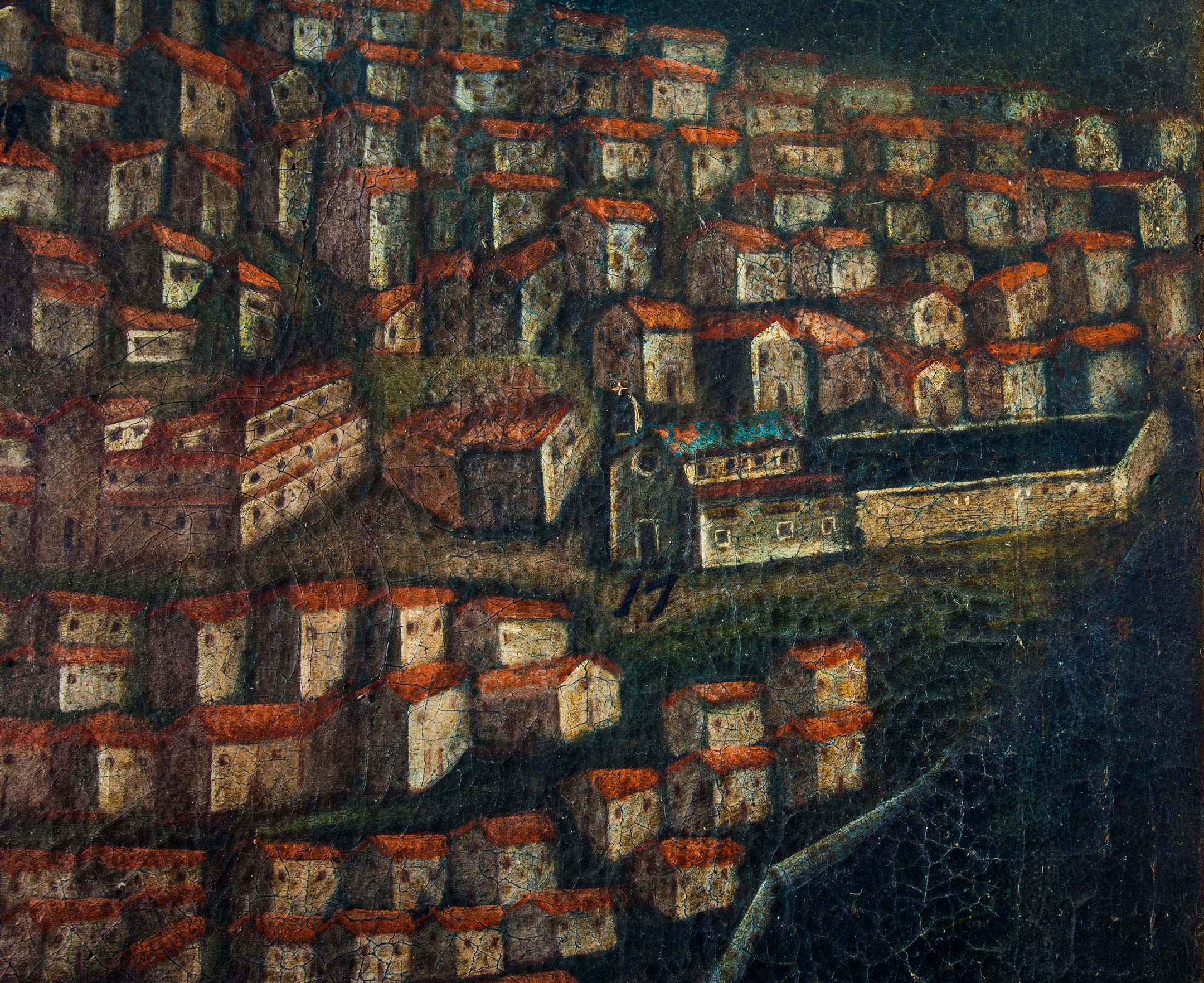
Sortino Patria Antica – Particolare. Monastero di San Benedetto. Foto di Diego Barucco.
1693. Earthquake
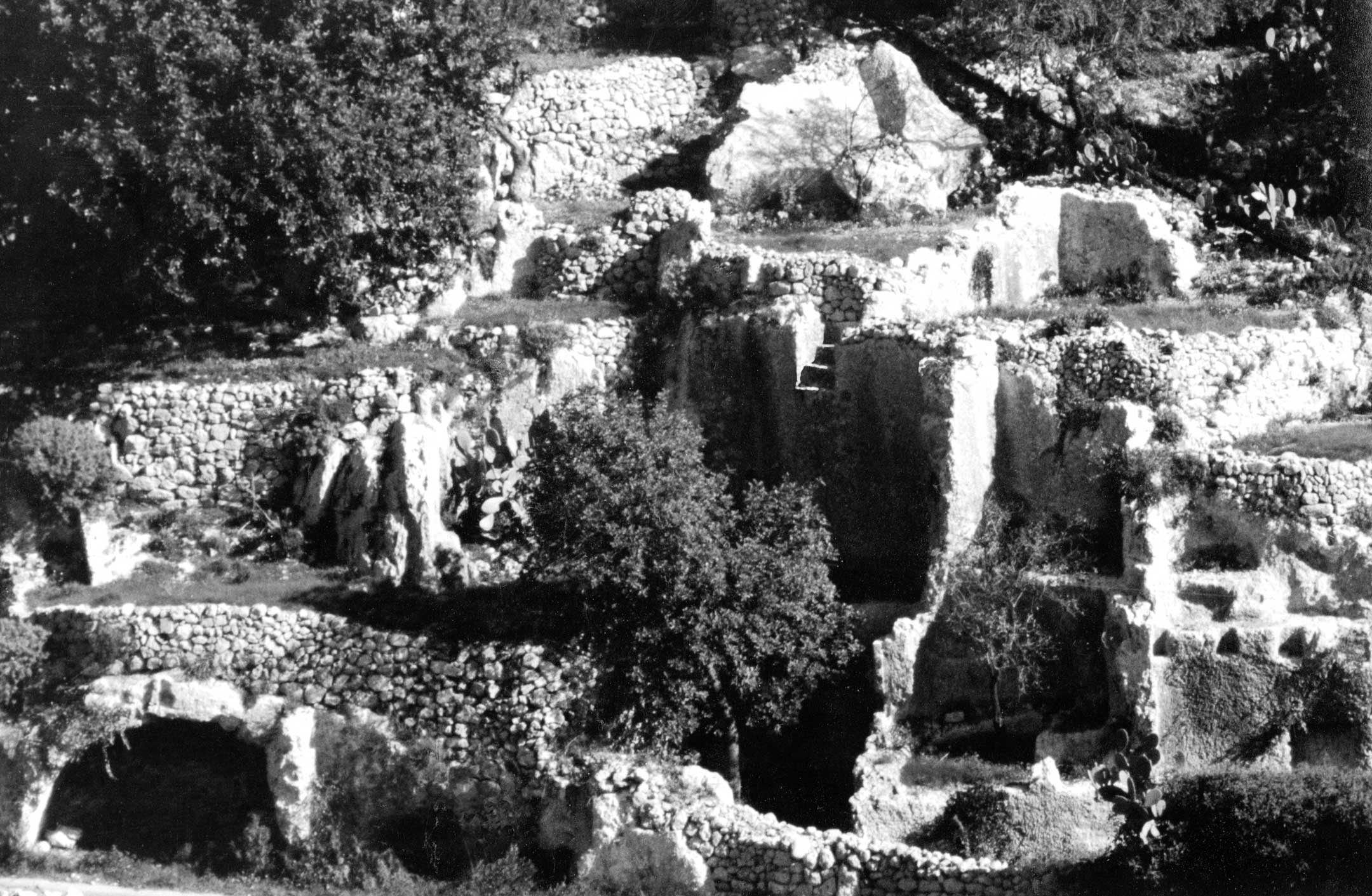
Ruderi dell’abitato di Sortino Antica. Lastricheddu. Foto di Gioacchino Bruno.
Between January 9th and 11th, 1693, the whole Noto Valley was hit by a violent earthquake, of a power today estimated around 7.4 Richter, which drastically changed the settlement patterns all over the island and was followed by a majestic work of reconstruction. Sortino suffered the death of more than 3000 inhabitants and the complete destruction of the town which, on order of the Gaetanis, was re-built more to the North, on top of the Aita mount. “On January 9th, 1693, around 4 am, when everything was in absolute silence, the earth shaked from deep down. This earthquake was so terrible that it made all steeples fall down, the bell of S. Antonio break into pieces and buried many men under the ruins. (...) After having spent all night providing aid and charity, when the daylight came the people saw how big the loss was in terms of buildings, friends, families and fellow citizens; therefore they grouped together in several places and cried, confused and inconsolable. (...) right when the people, with eyes wet of tears and hearts full of devotion, sang holy hymns, then the land shaked again, leaving neither a single church nor house standing. Then huge rocks broke from the mountain, that is the rocky flank on which the town was built, and they started rolling towards and on the town, destroying every building on their path. The amount of people dead under the stones was certainly high, as the count was around 3700” (Gurciullo, Notizie delle Chiese di Sortino, second half of the XVIII century). Furthermore, it is still the priest Gurciullo to maintain that the earthquake had been prophetized by a nun of the Monastery of Montevergine, Cesaria Celona, deceased in 1692.
1697. S. Maria del Casale and the recovery of the statue of Jesus tied to the column
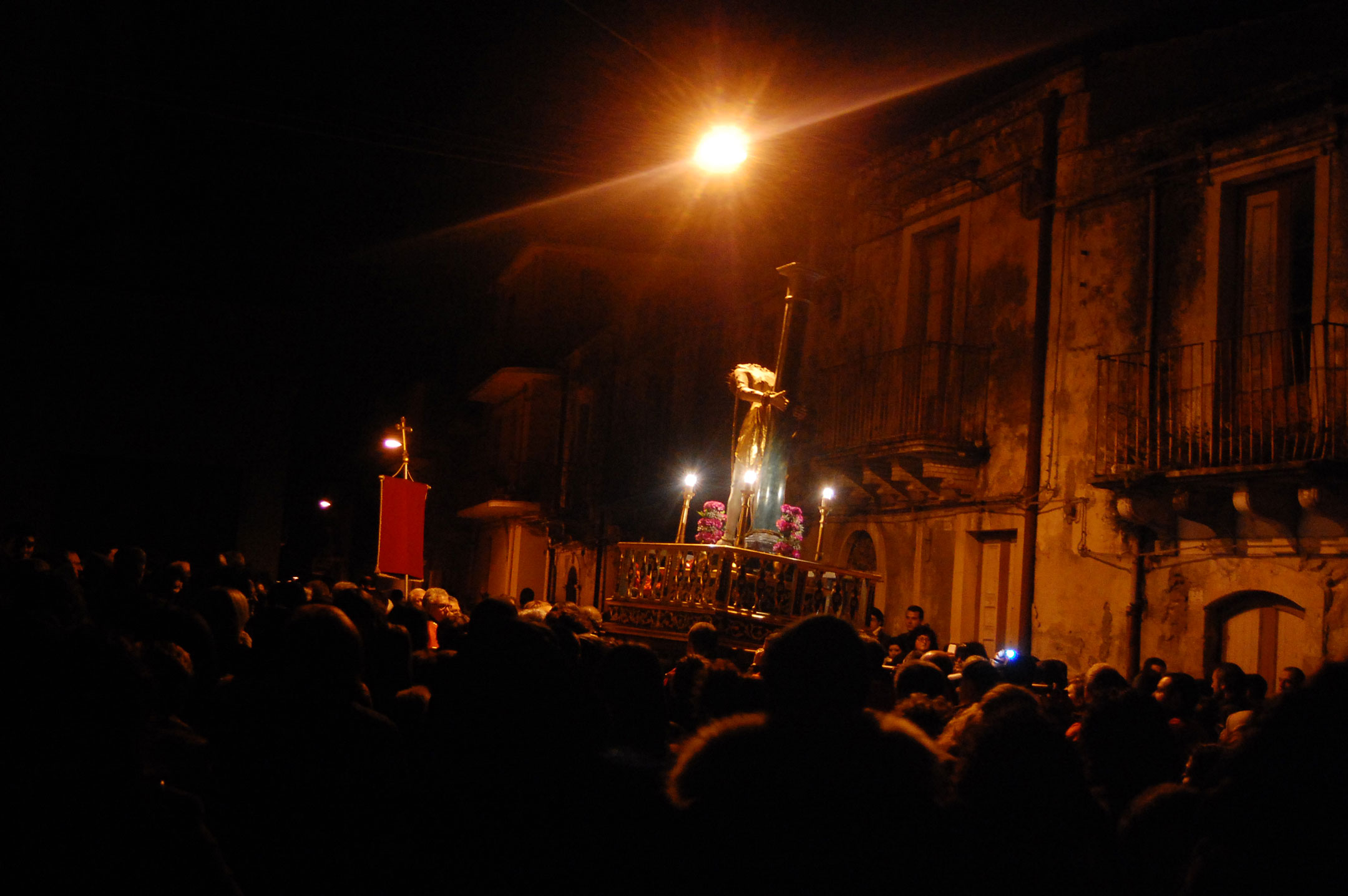
Sortino - Processione del Venerdì Santo con Cristo alla Colonna (Nummu ru’ Gesu). Foto di Dario Minnalà.
In the XVI century Sortino there was also a church called S. Maria del Casale, where was kept a statue of Jesus tied to the column. This statue was miraculously found under the ruins of the old town four years after the earthquake and then taken to the new Sortino, where it is still kept and venerated nowadays. “Located at the main altar of said church, which was in ordinary condition, was the statue of Jesus Christ tied to the column, very venerated by the devoted still today, and this stuatue was kept in a cave which served as chapel. (...) this statue was found intact under the ruins in 1697 and then brought in procession one year later upon license obtained from the Grand Bishop Court of Syracuse on March 22nd, 1698. The statue had been donated by the Company of the Holy Rosary, founded in 1642, which had the honor to take the statue of Christ tied to the column in procession on the night of the Good Friday with the black banner. Such procession, which still takes place nowadays, was very evocative, since it began at one at night. “(...) this stuatue is usually followed in procession by almost the whole population of the town, many in penitence, as most of them, mostly the women, go bare feet, while others hit themselves to bleed, either with a rag or without (...) back then the procession would end around 4 am” (Gurciullo, Notizie delle Chiese di Sortino, second half of the XVIII century).
SS. Maria del Soccorso
The only church which was not completely destroyed by the 1693 earthquake was SS. Maria del Soccorso, which is still visible today, although very damaged. “The building did not collapse with the 1693 earthquake, although the ceiling fell down, and the image of Holy Mary, painted in the rock, is still visible today. The location of the church is exactly in the middle between ancient Sortino and the church of the SS. Annunziata, attached on its feet to the cliff, and it was in this church that every Saturday the Holy Sacrifice was celebrated.” (Gurciullo, Notizie delle Chiese di Sortino, second half of the XVIII century).
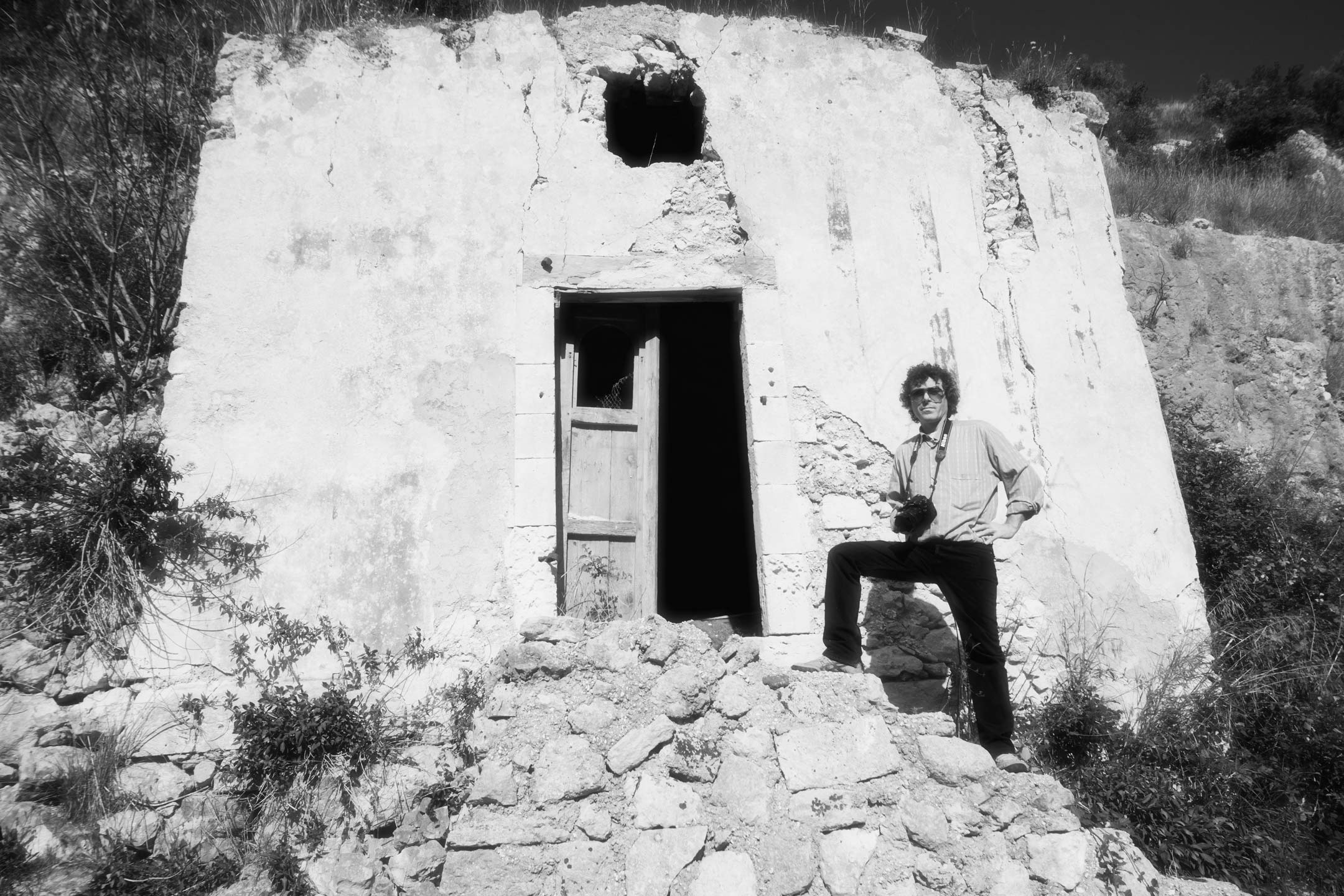
Ruderi della Chiesa di S.S Maria del Soccorso con Gioacchino Bruno, fotografo e studioso di Sortino Antica. Foto di Diego Barucco.
S. Francesco di Paola
Right below the castle, over a very high cliff, where was the entrance of the ancient Sortino, not far from the upper side of the scala nova (new stairway), was the church of SS. Maria della Visitazione, also known as della porta (“of the door”). Together with the scala nova, this church also collapsed during the 1693 earthquake. Now “it is an entrance through which the people walks towards the ancient land not far from the small chapel of S. Francesco di Paola” (Gurciullo, Notizie delle Chiese di Sortino, second half of the XVIII century). In this place is now a small church dedicated to the saint.
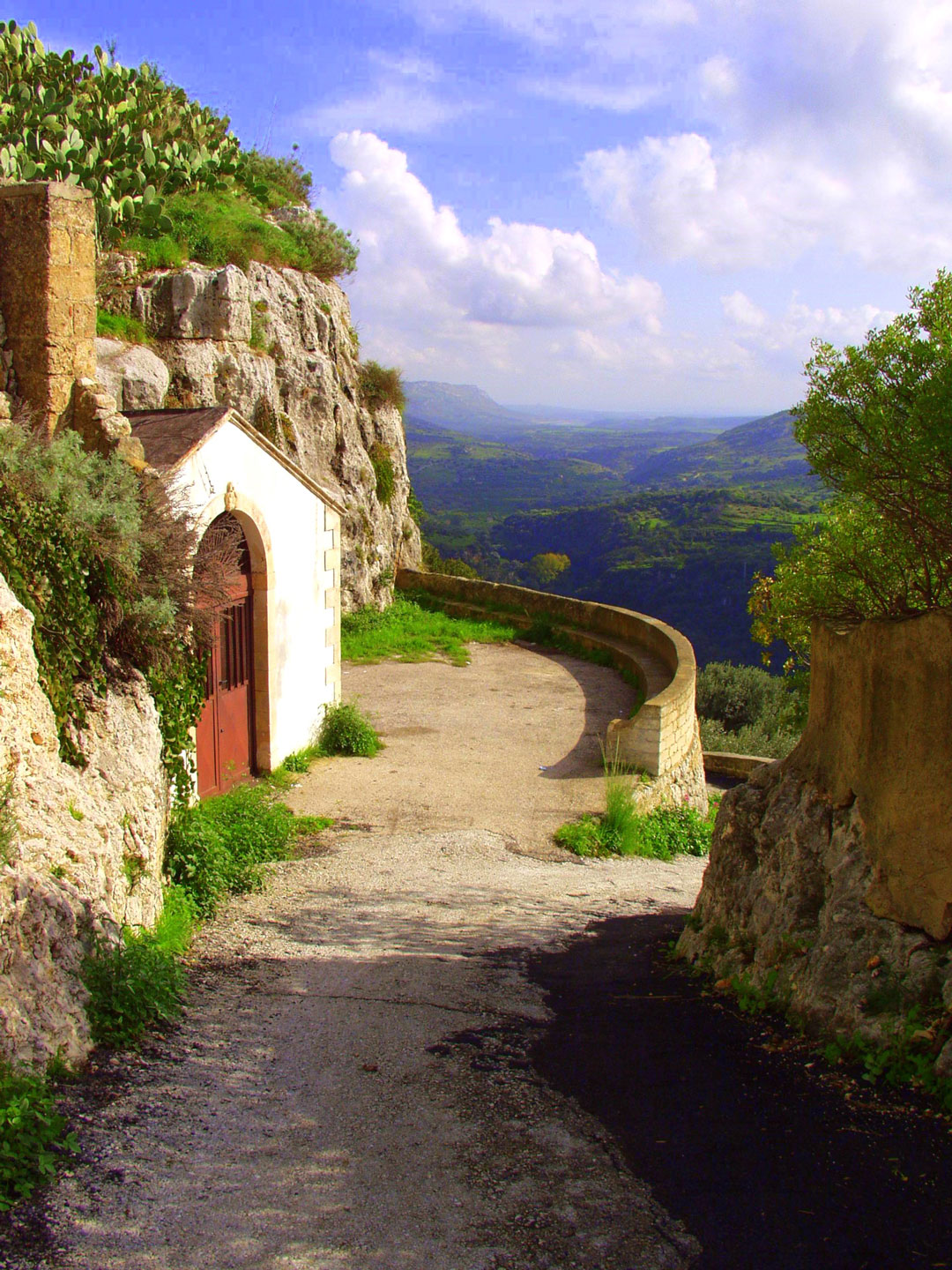
Cappella di S. Francesco di Paola e panorama della Valle dell’Anapo. Foto di Dario Minnalà.
The site in the XVIII century
Despite the terrible earthquake of 1693, the site kept living in the following centuries. On the occasion of the celebration of the Assumption, for instance, the people used to gather around the church of S. Maria della Catena, located at the western border of the town. The priest Gurciullo reminds us that “after the mass, the people would go to those garden to relax, eating fruit and having a bit of the stew, prepared for whoever wanted to have some. After lunch, the people would stay there and have fun, with kids running around and arranging prizes for the one who managed to reach first the previously indicated spot. There, a tall wooden lintel was set, oiled with fat and with the prize placed at its top, awaiting the one who would climb the lintel” (Gurciullo, Notizie delle Chiese di Sortino, second half of the XVIII century).
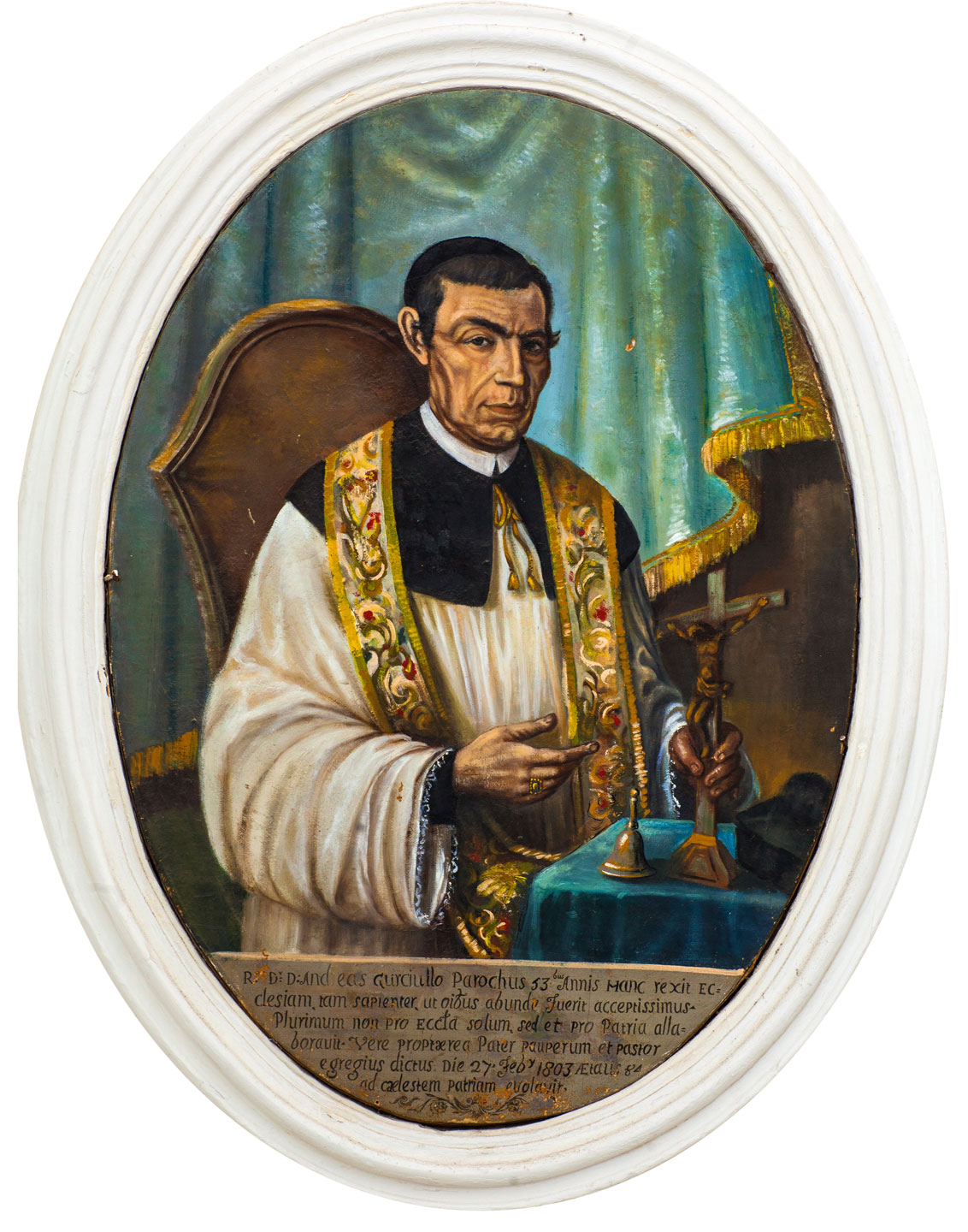
Parroco Andrea Gurciullo, ritratto. Chiesa Madre di Sortino ( Diritti Riservati ). Foto di Diego Barucco.
Factories
From the painting of the XVIII century which depicts the inhabited area of Sortino before the 1693 earthquake, it is possible to see, particularly around the Guccione river, several factories, mostly located inside natural or artificial caves. Such factories were still used in the XVIII century, and some of them can still be visited today.
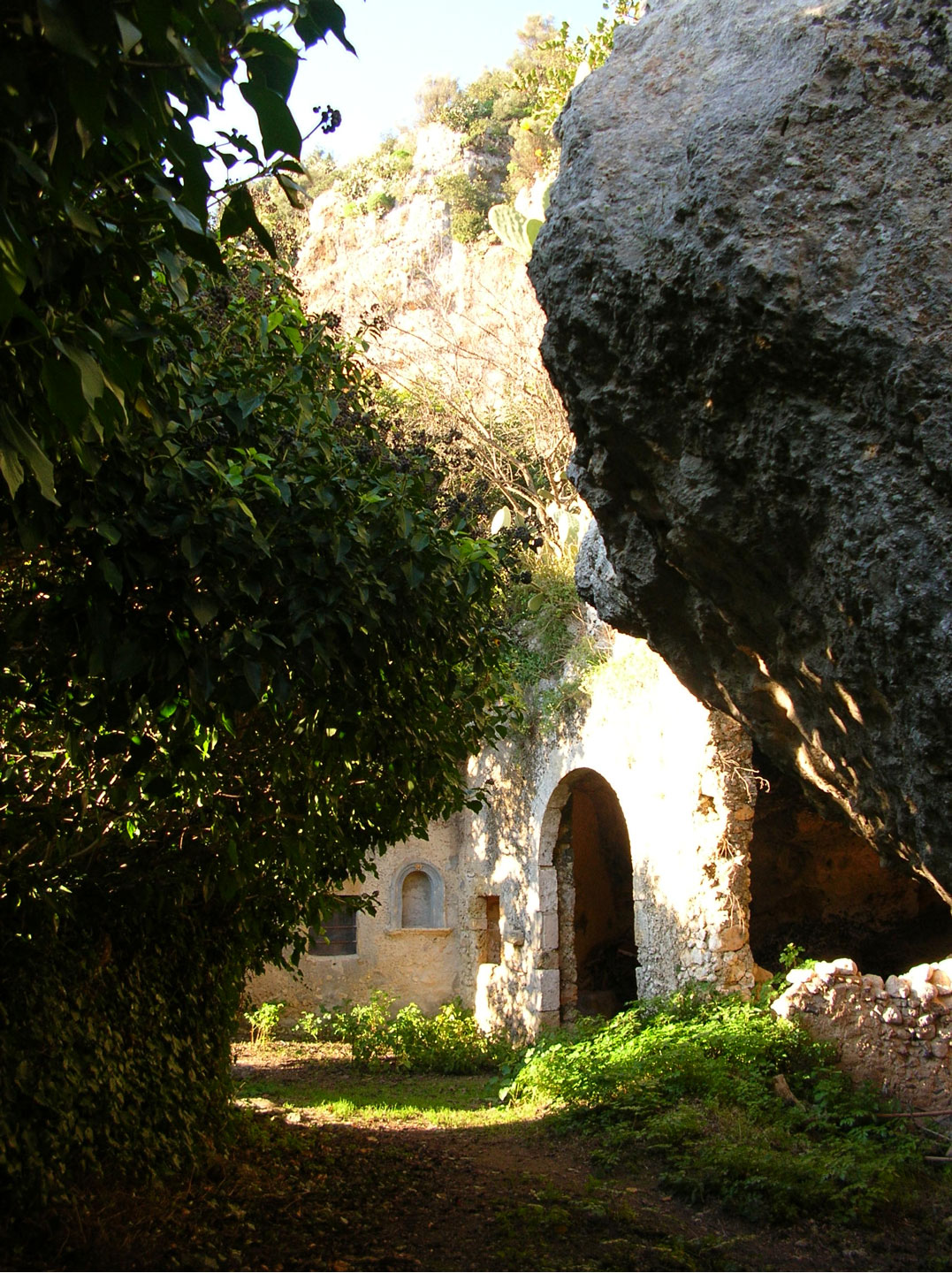
Ruderi del Frantoio di C.da Za’ Pasqua. Foto di Dario Minnalà.
Olive oil mills
On the edge of the western side of the site is a factory used both for the production of gunpowder and as an olive oil mill. In order to avoid thefts and frauds, at the end of the XVIII century the viceroy Caramanico commanded that “the olive oil mills must have only one door, located on the public way (...) and no internal communications, neither through doors nor through windows”.
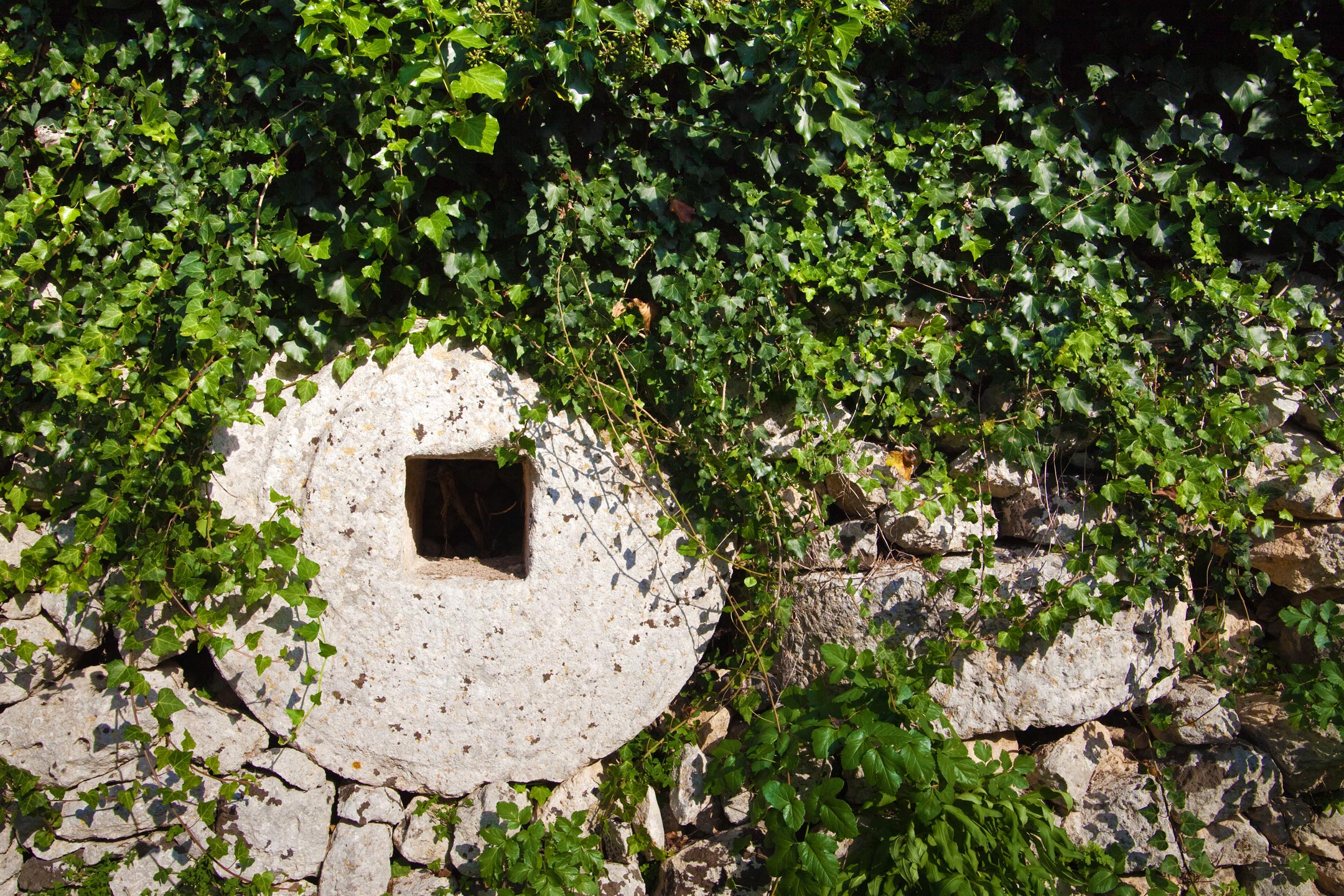
Macine in muro a secco, C.da ‘Mprimmu. Foto di Diego Barucco.
Tanneries
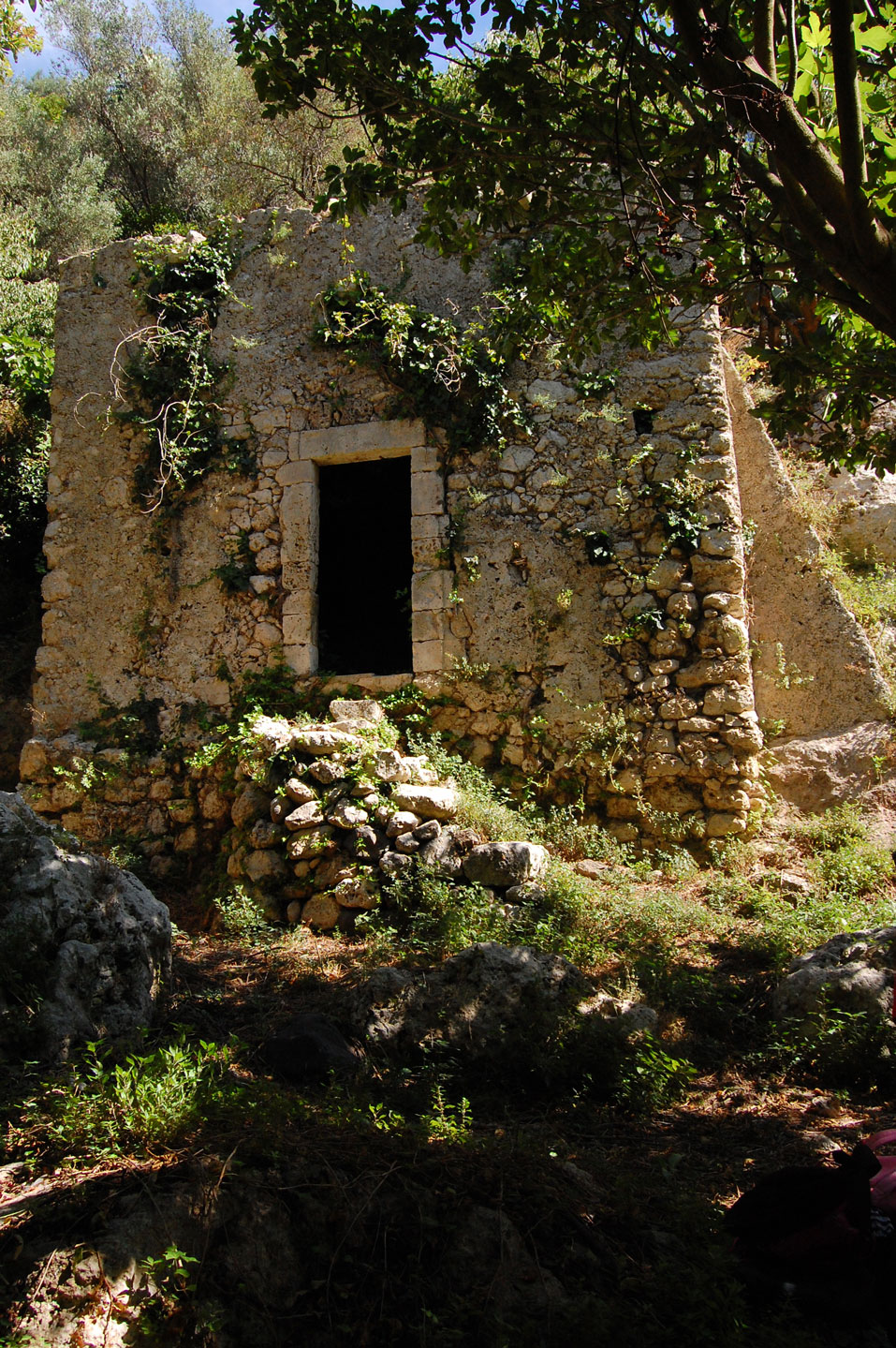
Ruderi della conceria Manfre’ di Sortino Diruta. Foto di Dario Minnalà.
The ancient tanneries are today a place of untouched beauty. Located on the northern bank of the Guccione river, in the “Carcarone” neighborhood, one of the highly populated of the ancient Sortino, whose name probably came from carcara, the furnace used to turn limestone into lime, they were used until the first half of the XX century to produce leathers. Some of these are built in the caves, while others are external factories, although still connected to and in continuity with caves. The latter ones feature some kind of paved solarium made of local stone, which was used as dry kiln for the leathers. Inside the tanneries, some basins still show the signs of the ropes used to pull out the soaking skins. The tanning was carried out by moving the skins into basins filled with tannin, a vegetal substance which can be found in the Sicilian sumac, a very common plant in our area, whose importance is proved by the prohibition sanctioned by king Ferdinand to export its seeds, as “that would deprive this part of the kingdom of the exclusive trade of such a profitable product” and by the decree which prohibited its harvesting in the area of Sortino and in the Bifera woods, to both citizens and foreigners. According to the historic city archive, one of the tanneries belonged to the Manfrè family. A certain Nunzio Manfrè indeed declared he owned a tannery to tan every kind of cattle skin located in the old land of ancient Sortino and in the contrada of Ruggio. There is even an inscription, still visible on the lintel of the entrance door, which reads “Vito Manfrè 1779”, confirming the ownership. Another tannery belonged to the church of the SS. Annunziata, which declares it owns “a tannery in this territory called the tannery della Grutta (of the cave)”, while the owners of the two remaining tanneries were the church of S. Sofia and the monastery of Montevergine, with the annexes used to store the lime and the tanning materials.
1896. Flour mills and electric energy
On the opposite side of the inhabited area it is still possible to see the ruins of the flour mills, turned in 1896 into an electric plant, belonging to the families La Rosa and Serges. The old people of the town say that Sortino got the electric illumination before any other place. Giovanni La Rosa met in Catania a man who had just bought the cinematograph (invented one year earlier by the Lumiere brothers). Since he could not test it due to the lack of electric energy, he decided, on La Rosa's advice, to take the device to Sortino, where he arranged a public outdoor projection in Francesco Crispi square, right in front of the town hall, in the fall of 1896.
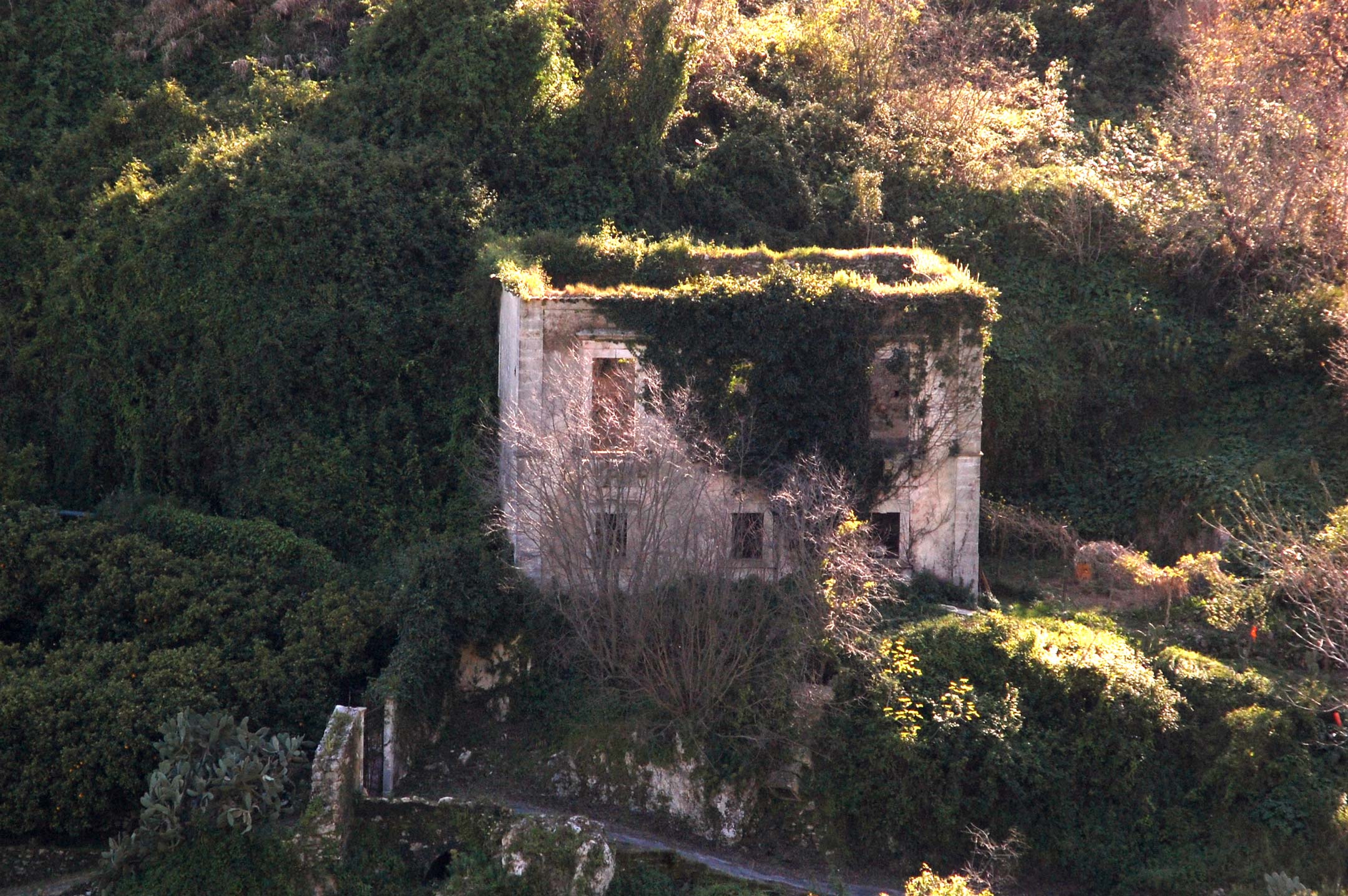
Ruderi del mulino La Rosa-Serges. Foto di Gioacchino Bruno.
1839. Old cemetery in Villa delle Rose
In 1839, the administration chose the square in front of the ancient castle as the appropriate location for the construction of the cemetery and a church. However, the latter turned out to be too large, in comparison with the small graveyard. For this reason, the administration opted for a smaller chapel. The cemetery, located where is today the garden known as Villa delle Rose, remainef in use until the end of the XIX century, when the site for the new cemetery was chosen.
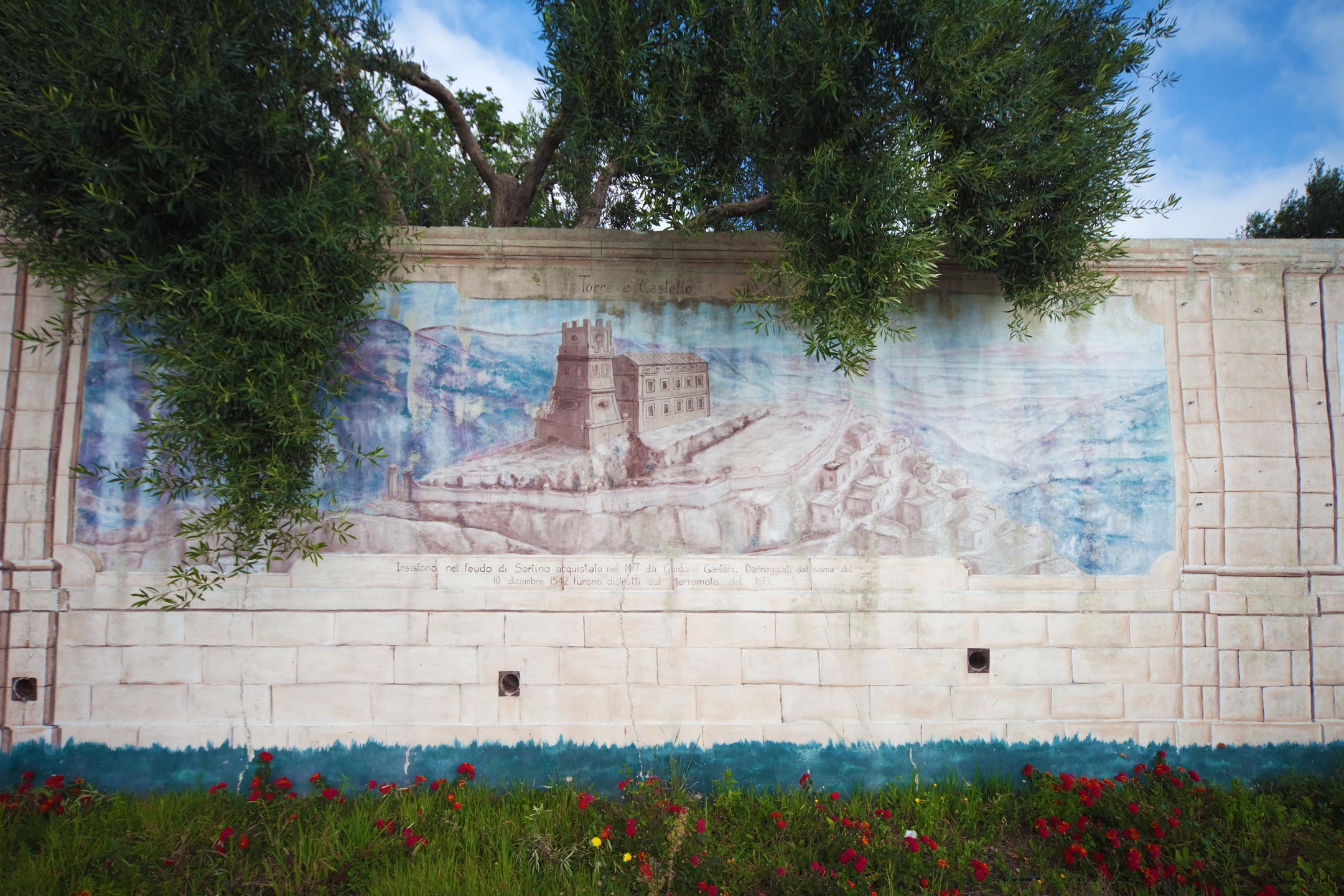
Murale di Villa delle Rose – Castello. 2002. S.Pane - A.Rapisarda - G.Bruno - M. Matera. Foto di Diego Barucco.
Early XX century. Citrus groves.
In the beginning of the XX century, the diffusion of the citrus groves, started already in the XVIII century, completely reshaped the agricultural landscape of Sortino. In particular, the terraces, the construction of primary irrigation systems and the installation of citrus groves in the site of the ancient Sortino have unavoidably jeopardized the topography of part of the once inhabited area, whose remains still unexpectedly emerge from the green of the giardini (citrus groves).
Edited by Selena Marino and Dario Minnalà.
Translated by Giovanni Calvo.
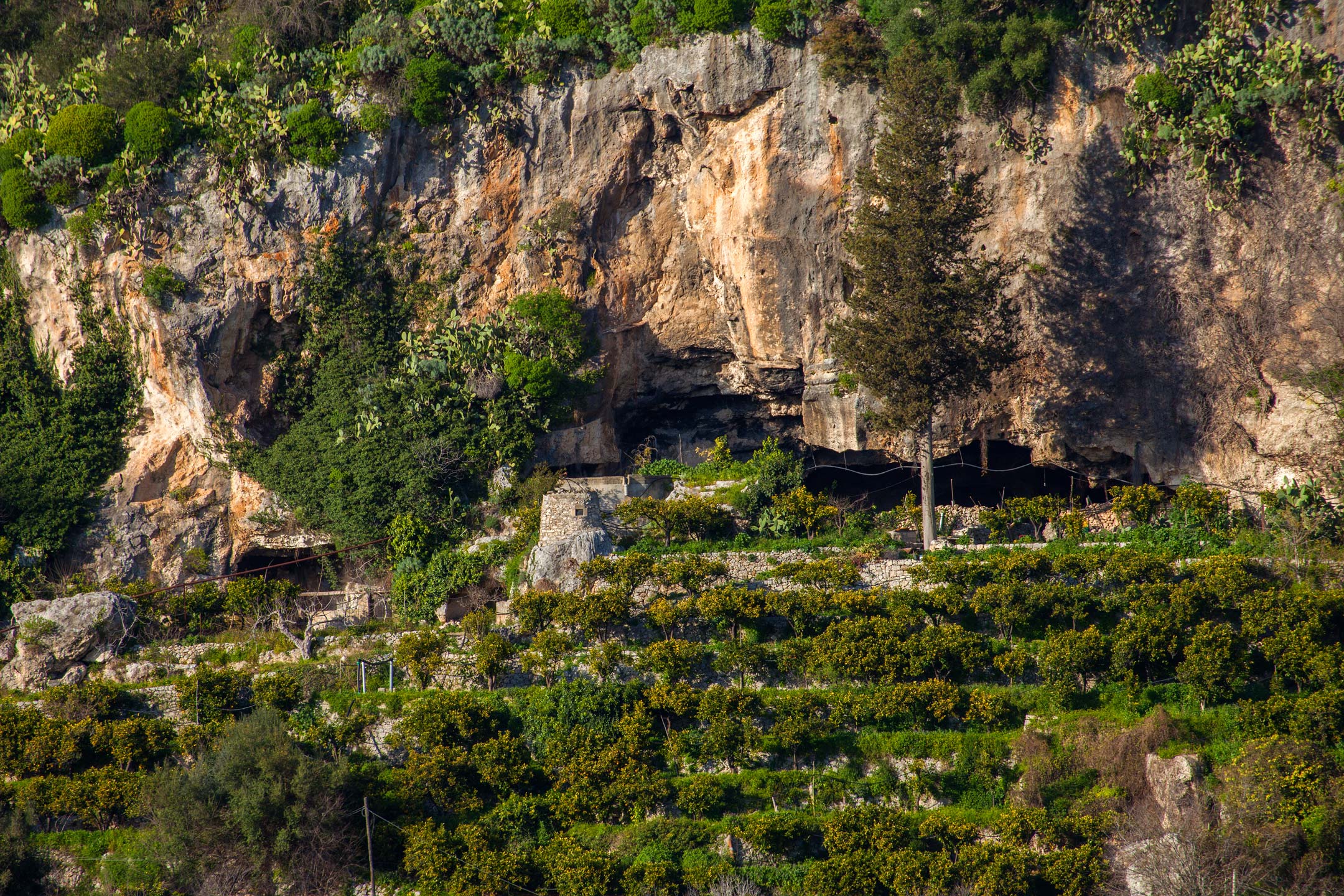
Agrumeti e grotte di Sortino Antica. Foto di Diego Barucco.
CreAZIONI giovani – Giovani protagonisti di sé e del territorio – Linea di intervento 1 “Laboratorio Sortino Antica”
Progetto finanziato dalla Regione Siciliana - Assessorato della famiglia, delle politiche sociali e del lavoro, e dalla Presidenza del Consiglio dei Ministri - Dipartimento della Gioventù e del Servizio Civile Nazionale.
Prog. CUP n° G56J16000320003 Decreto di Finanziamento DDG n°1324 del 07/06/2016
Sortino LAB – via Trieste, 2 – 96010 Sortino (SR)
sortinolab.info@gmail.com
dario.min@libero.it
cell: +39 3383455512

